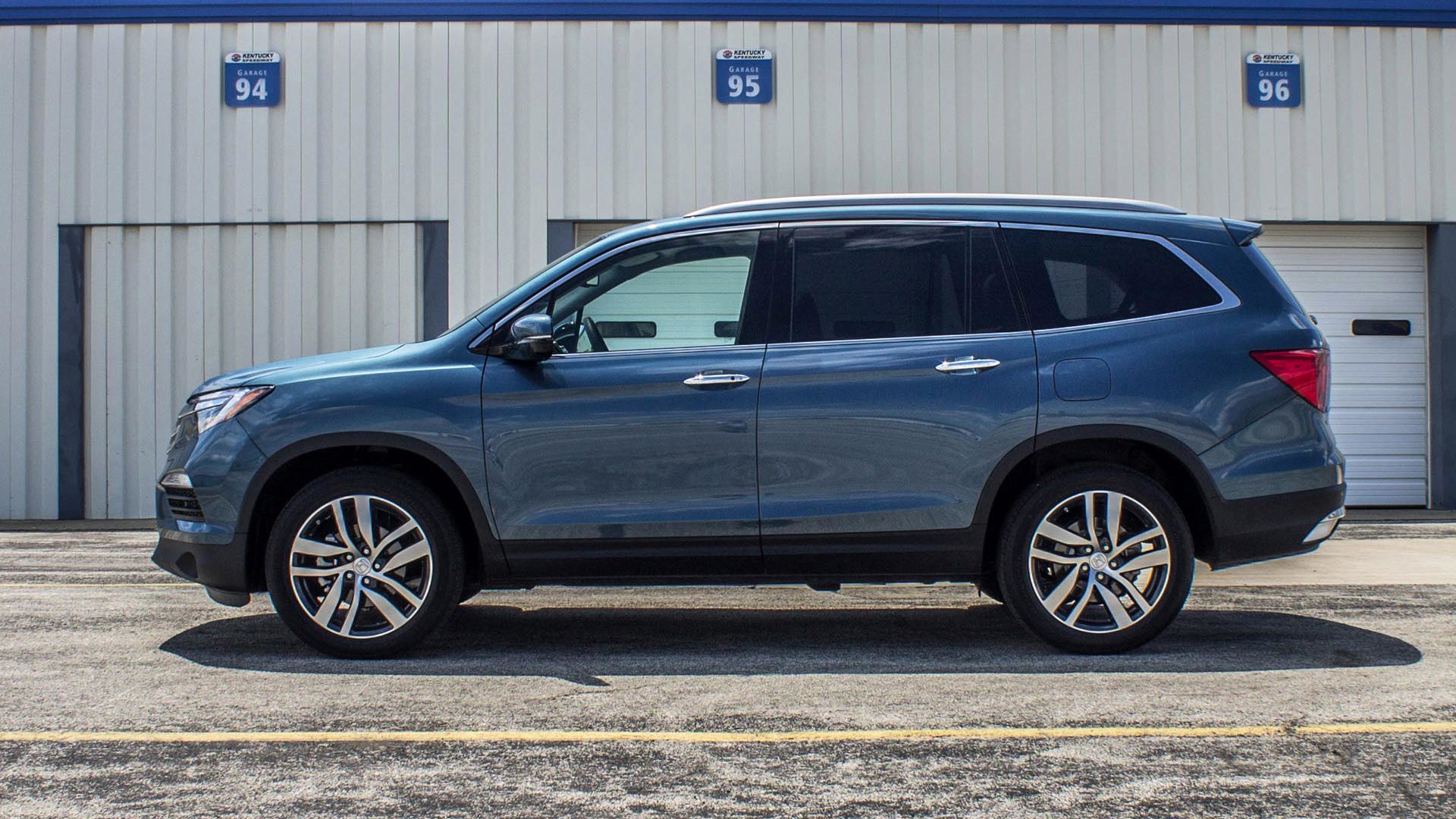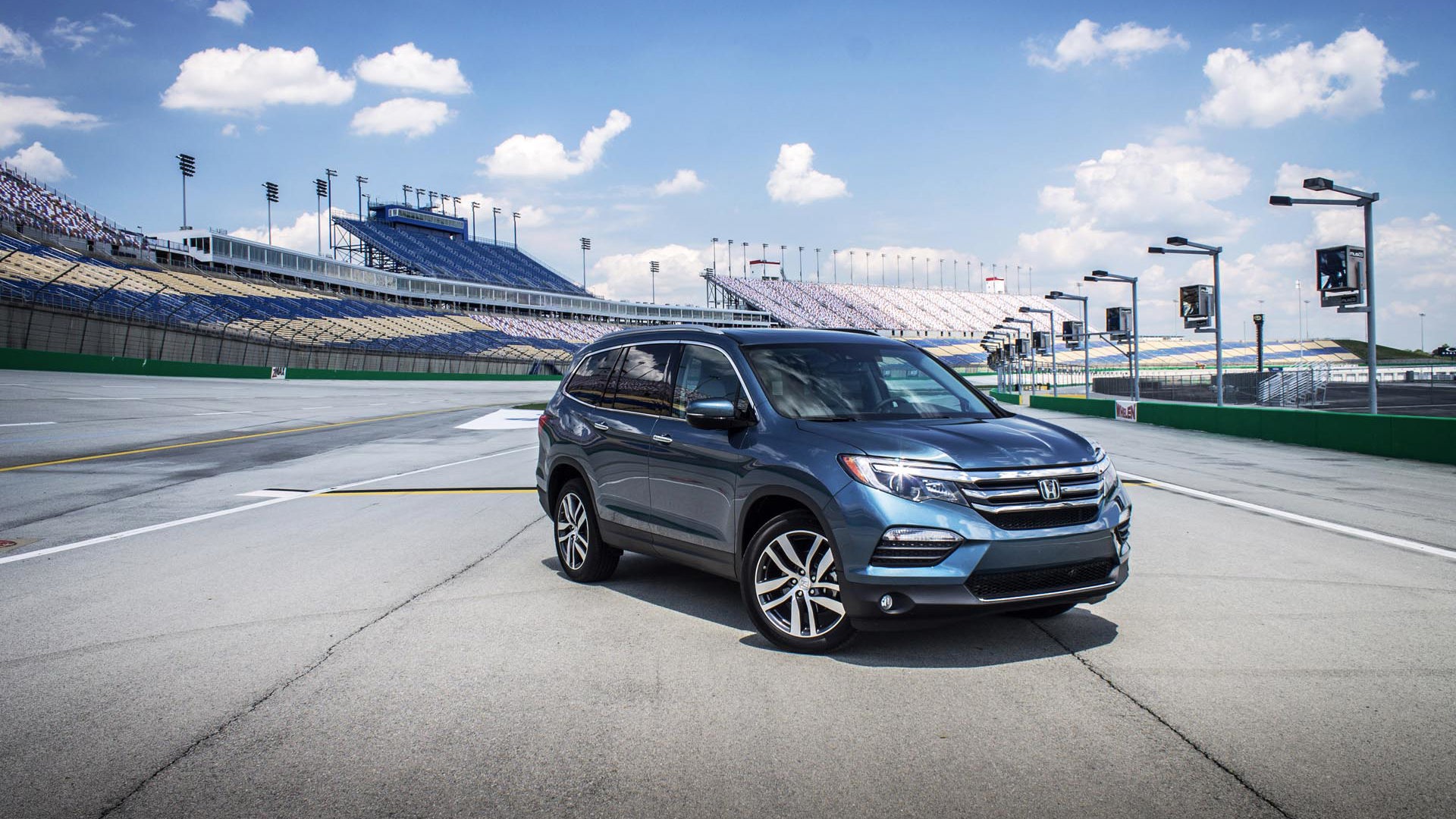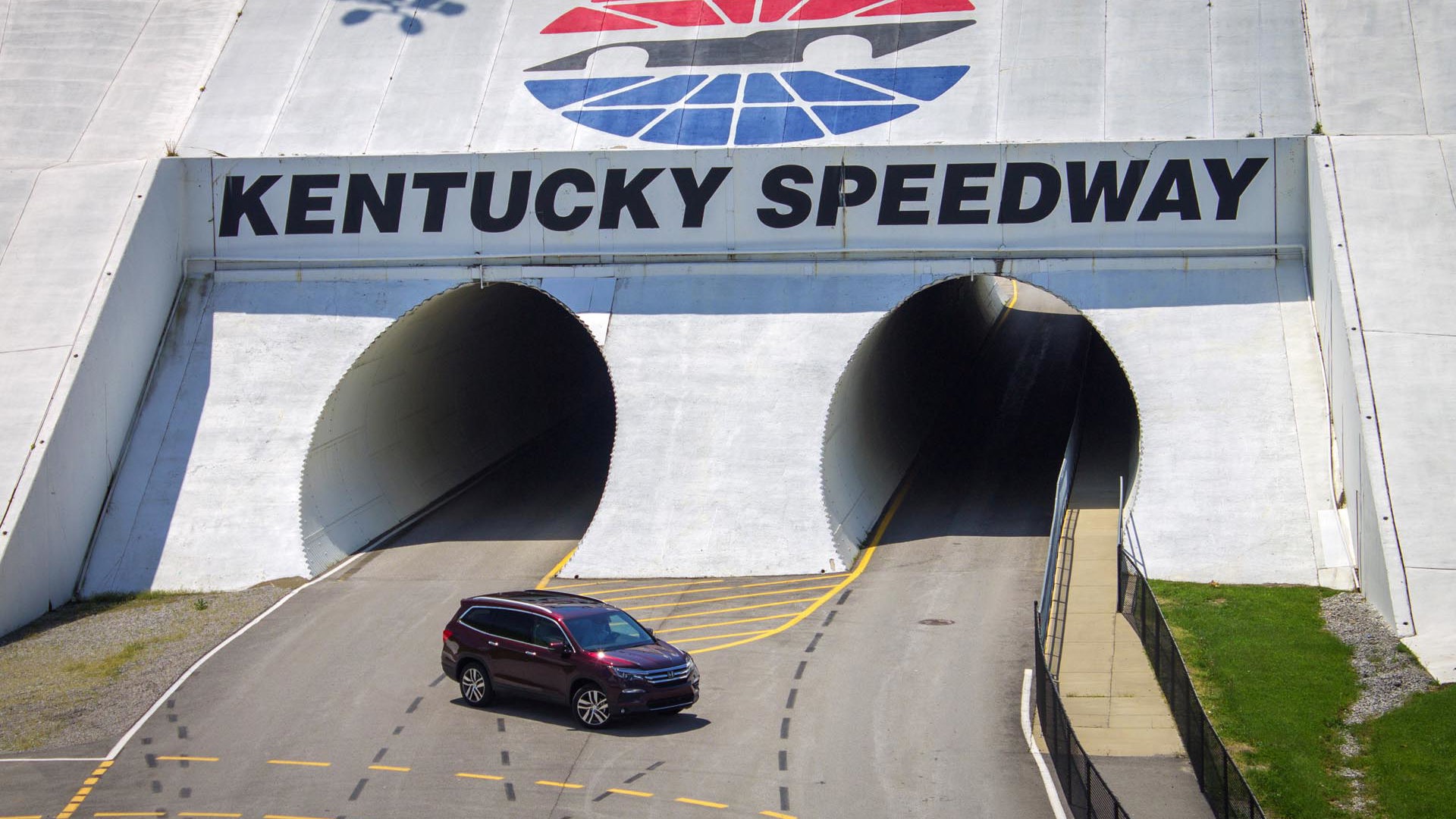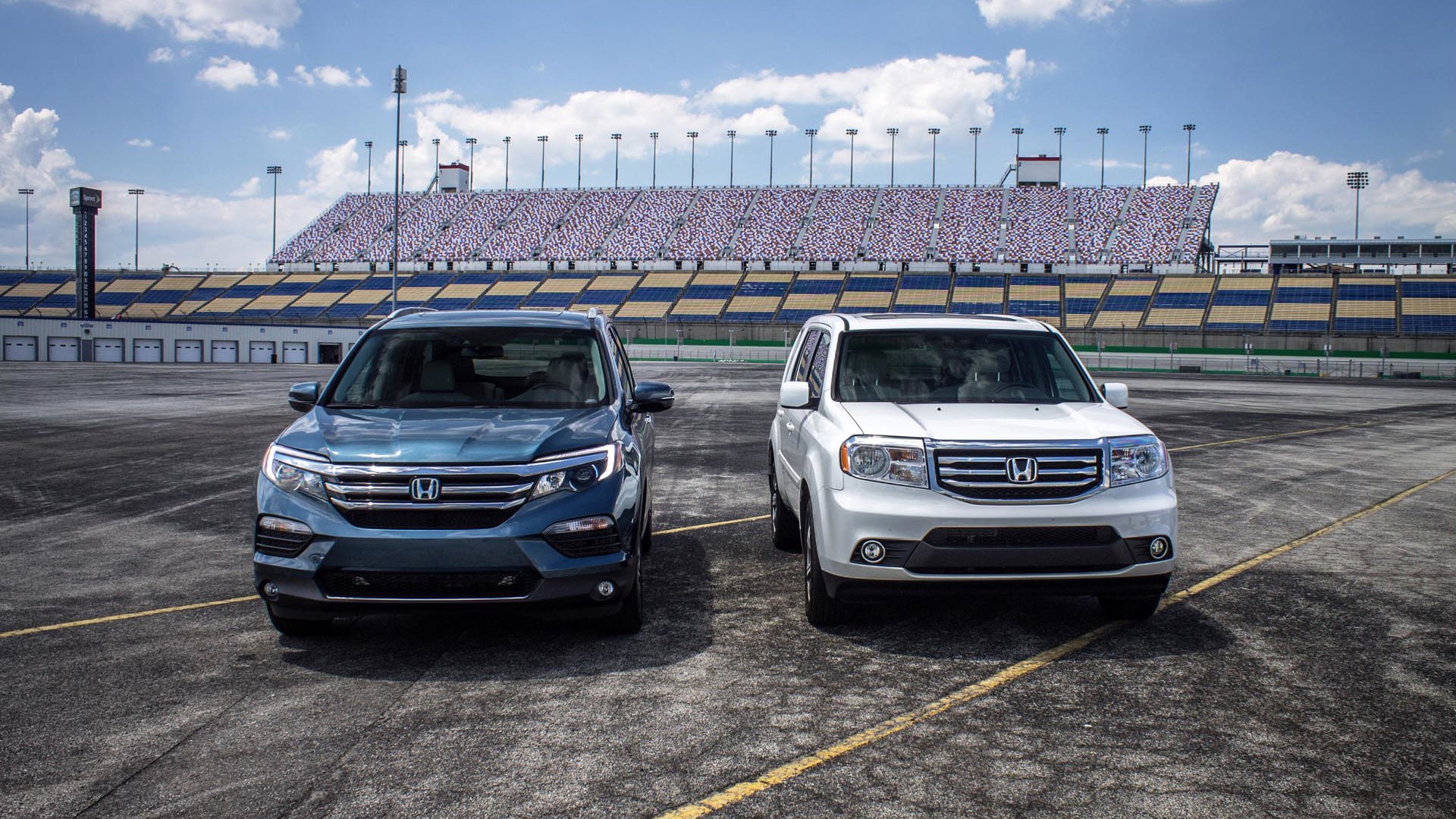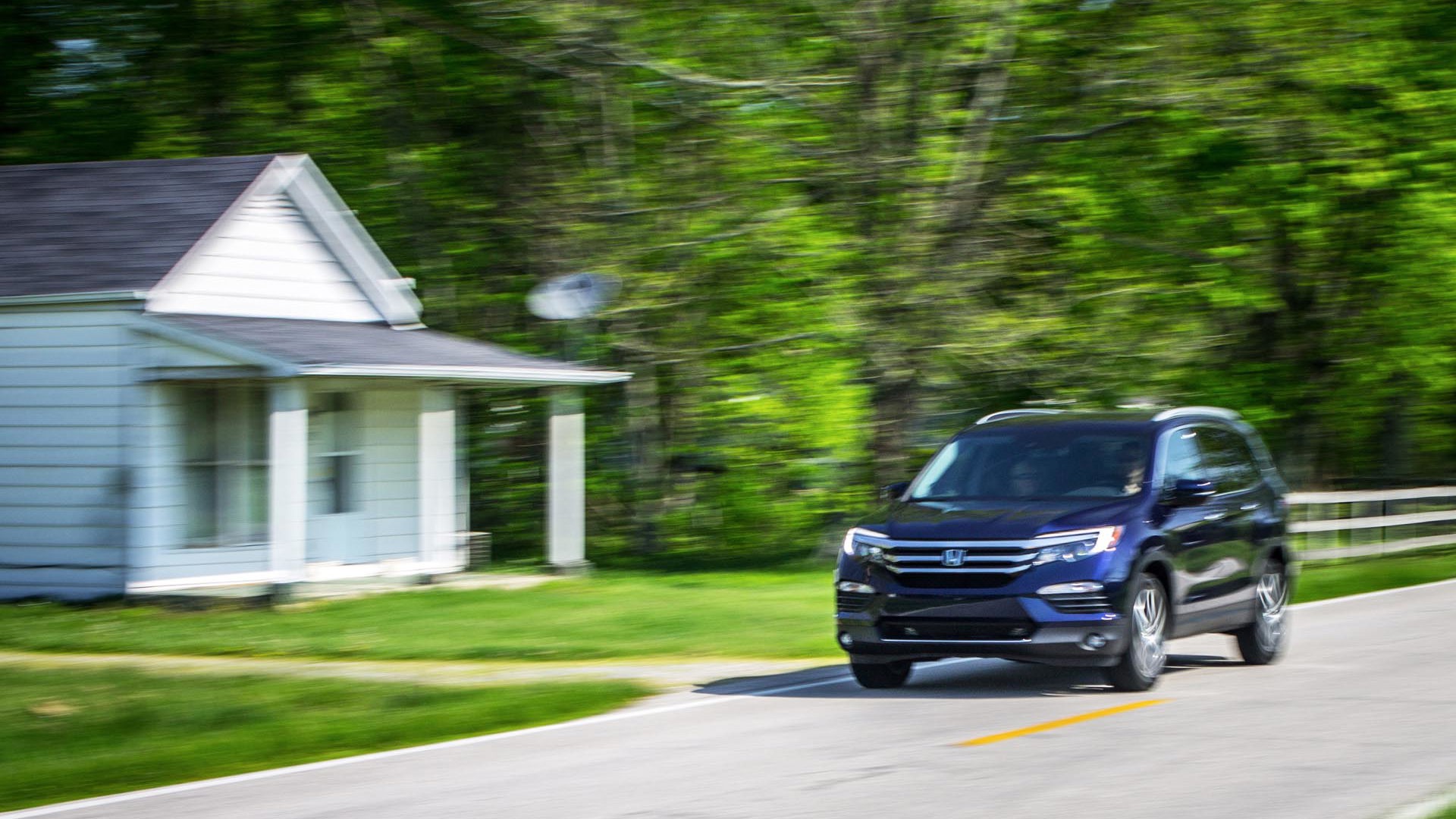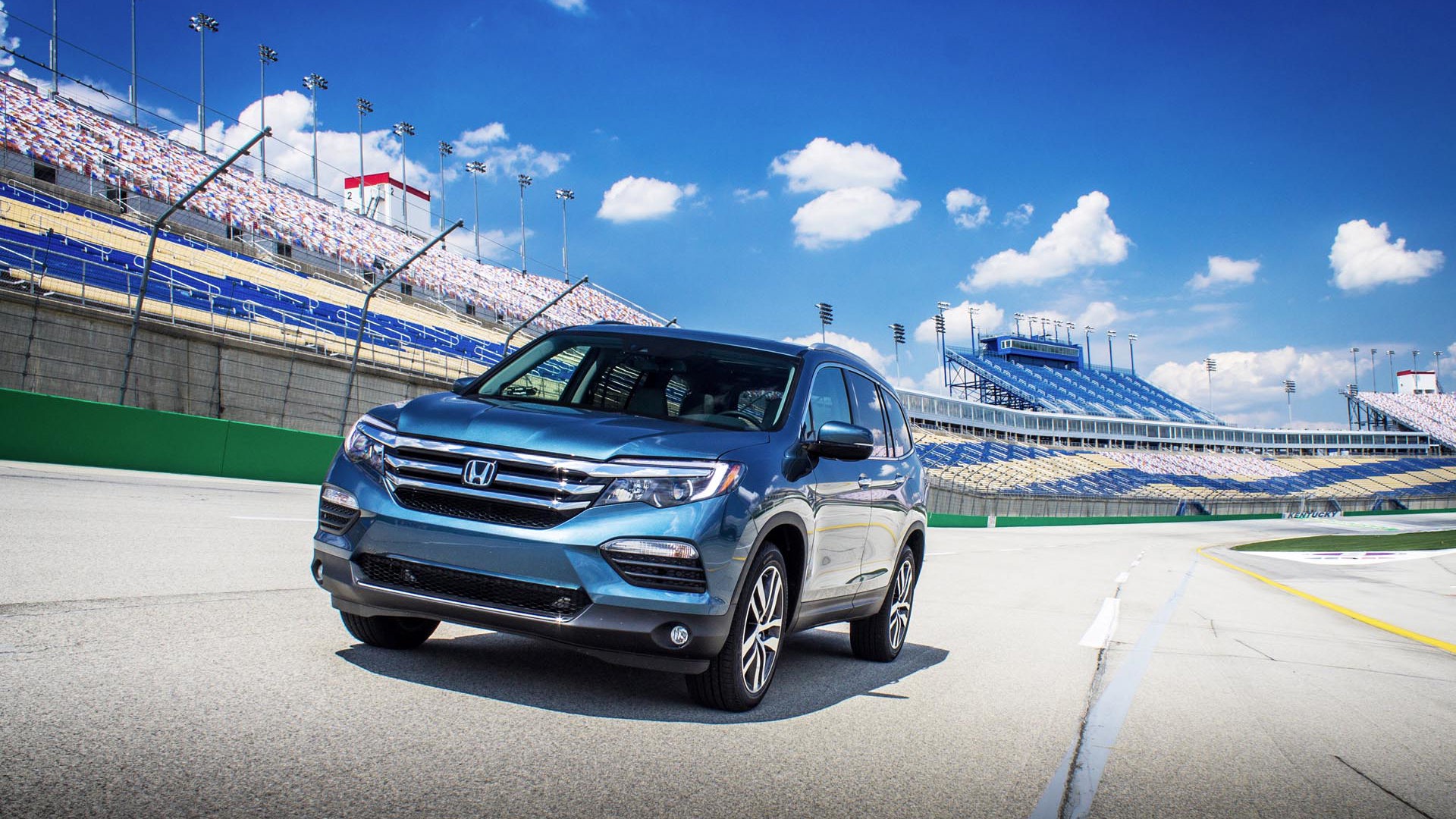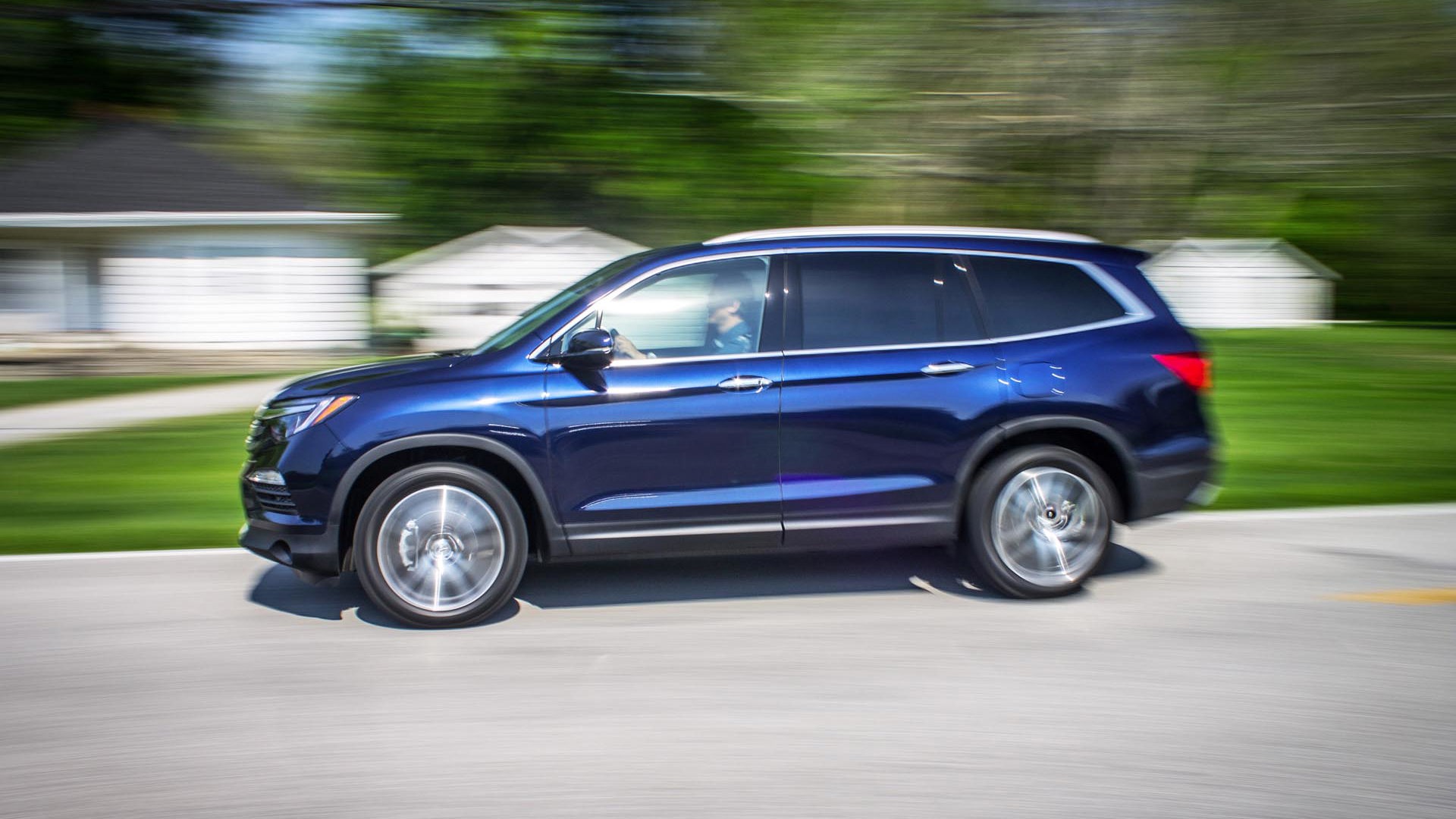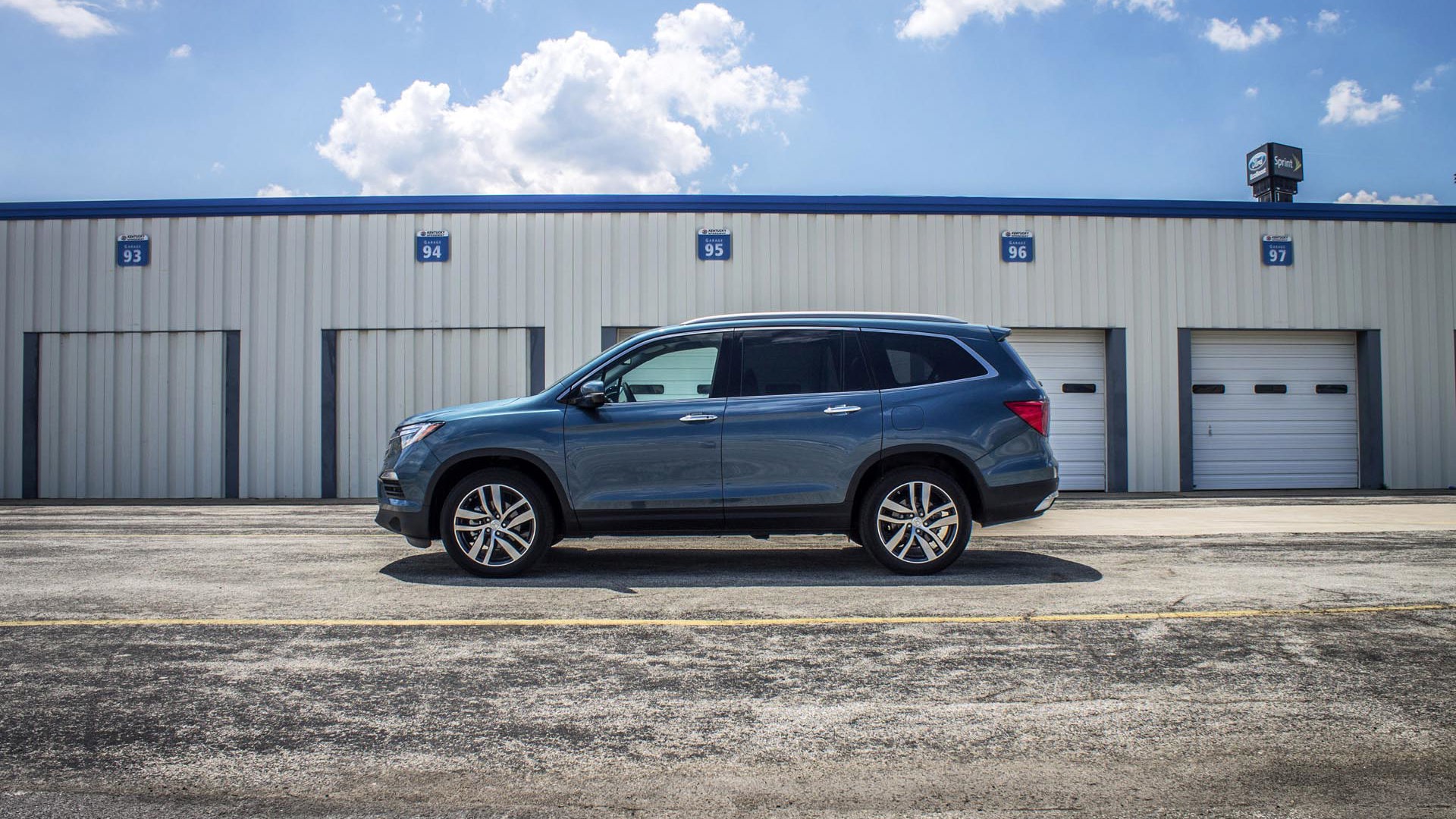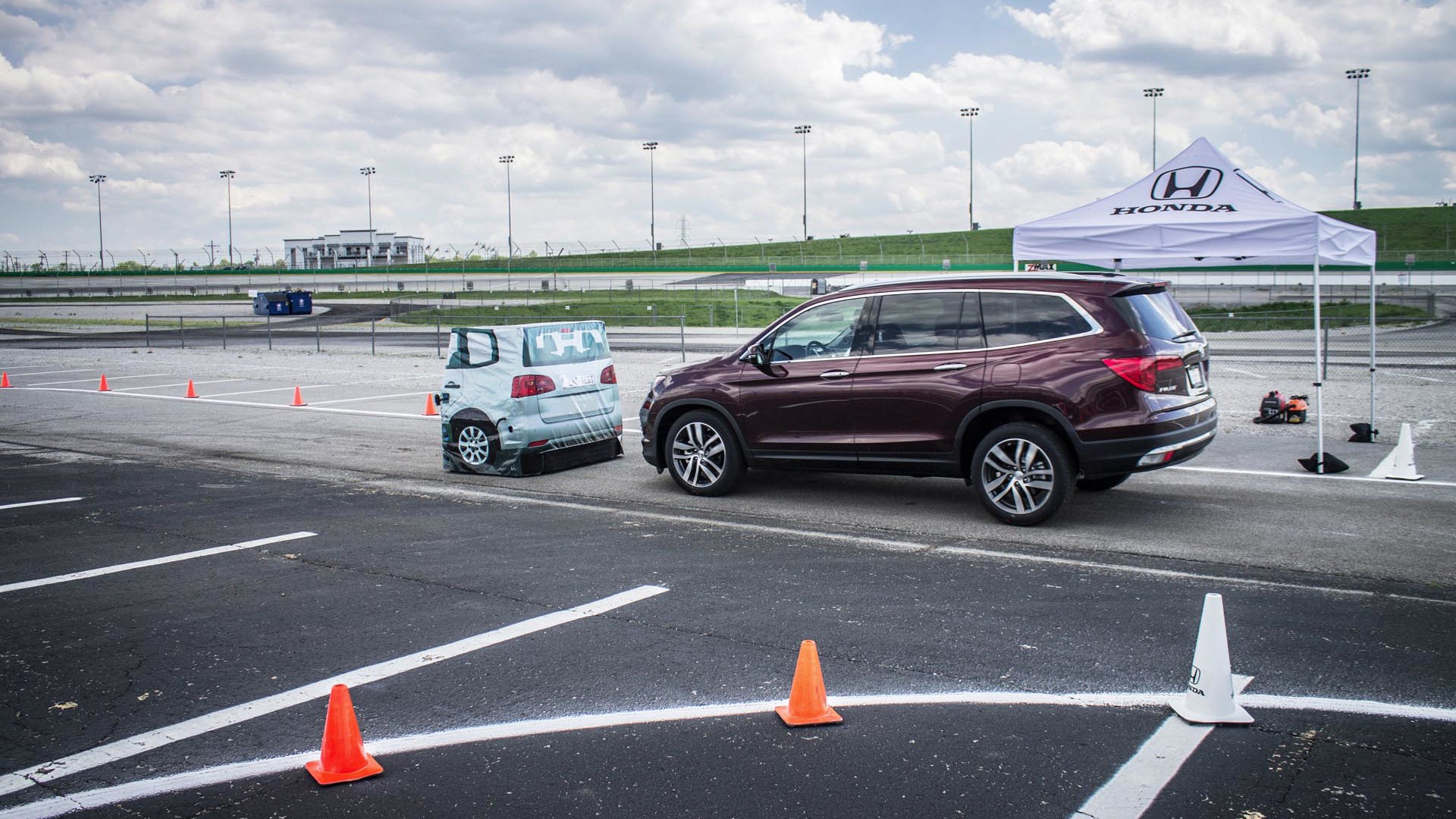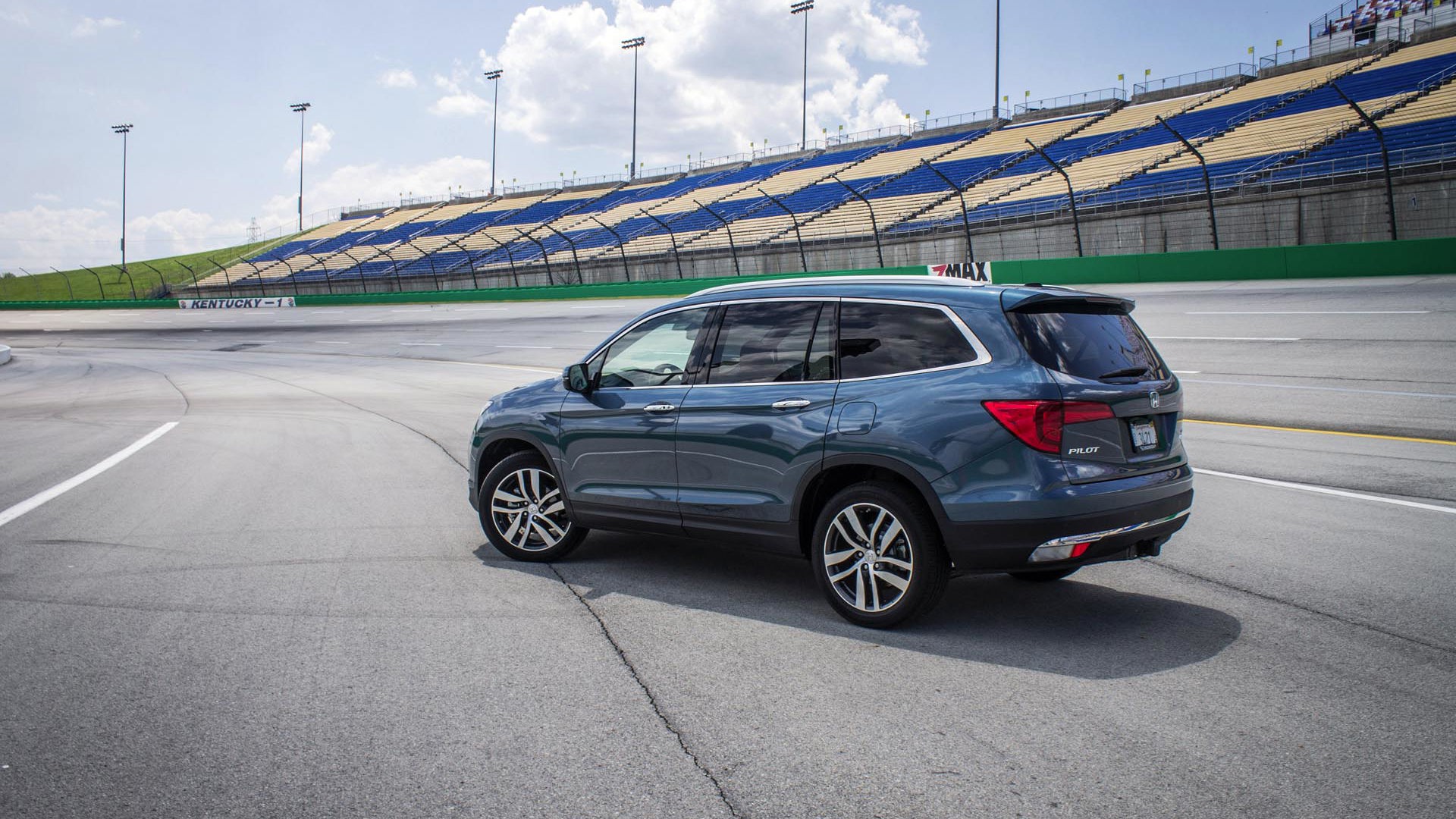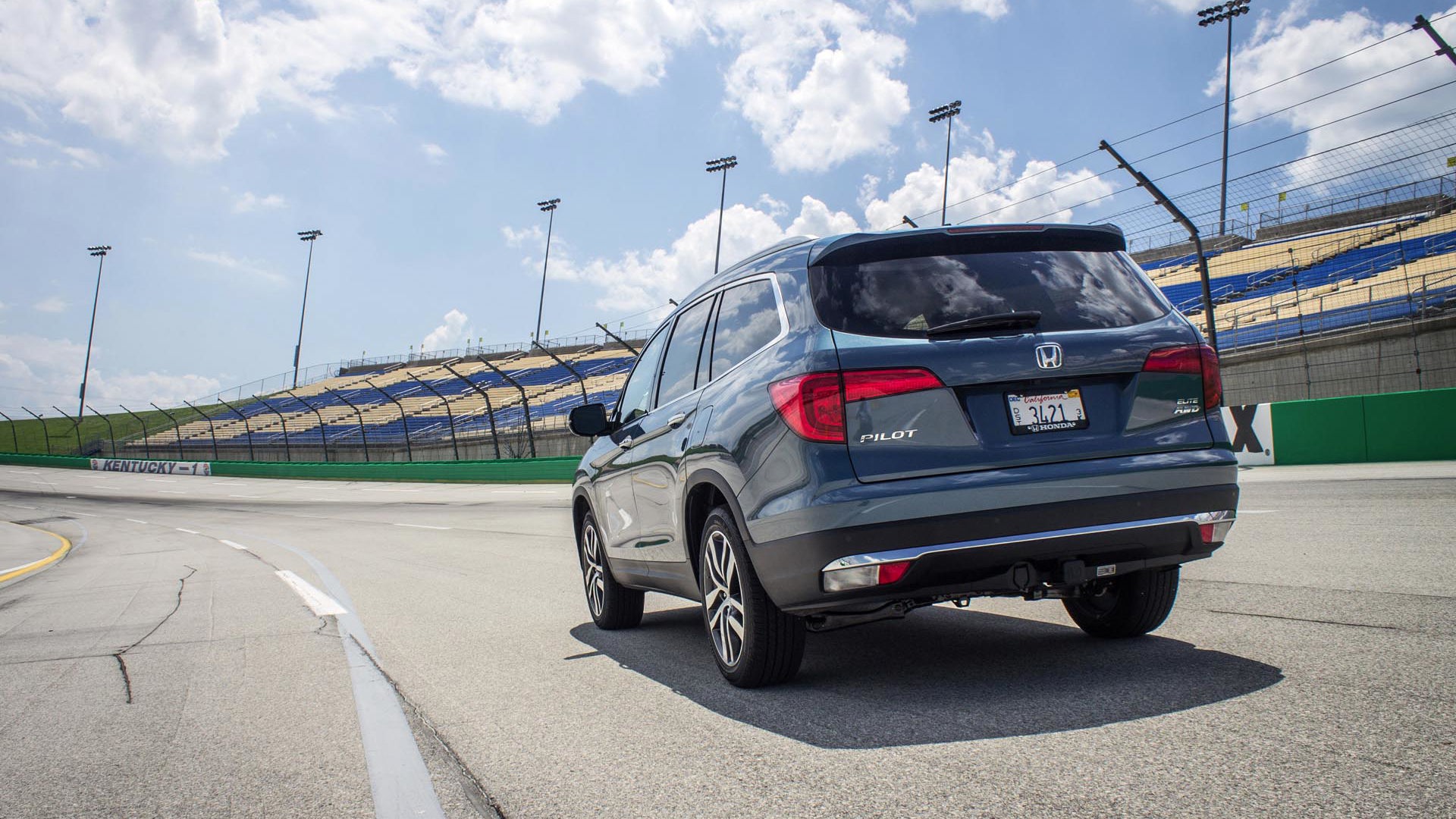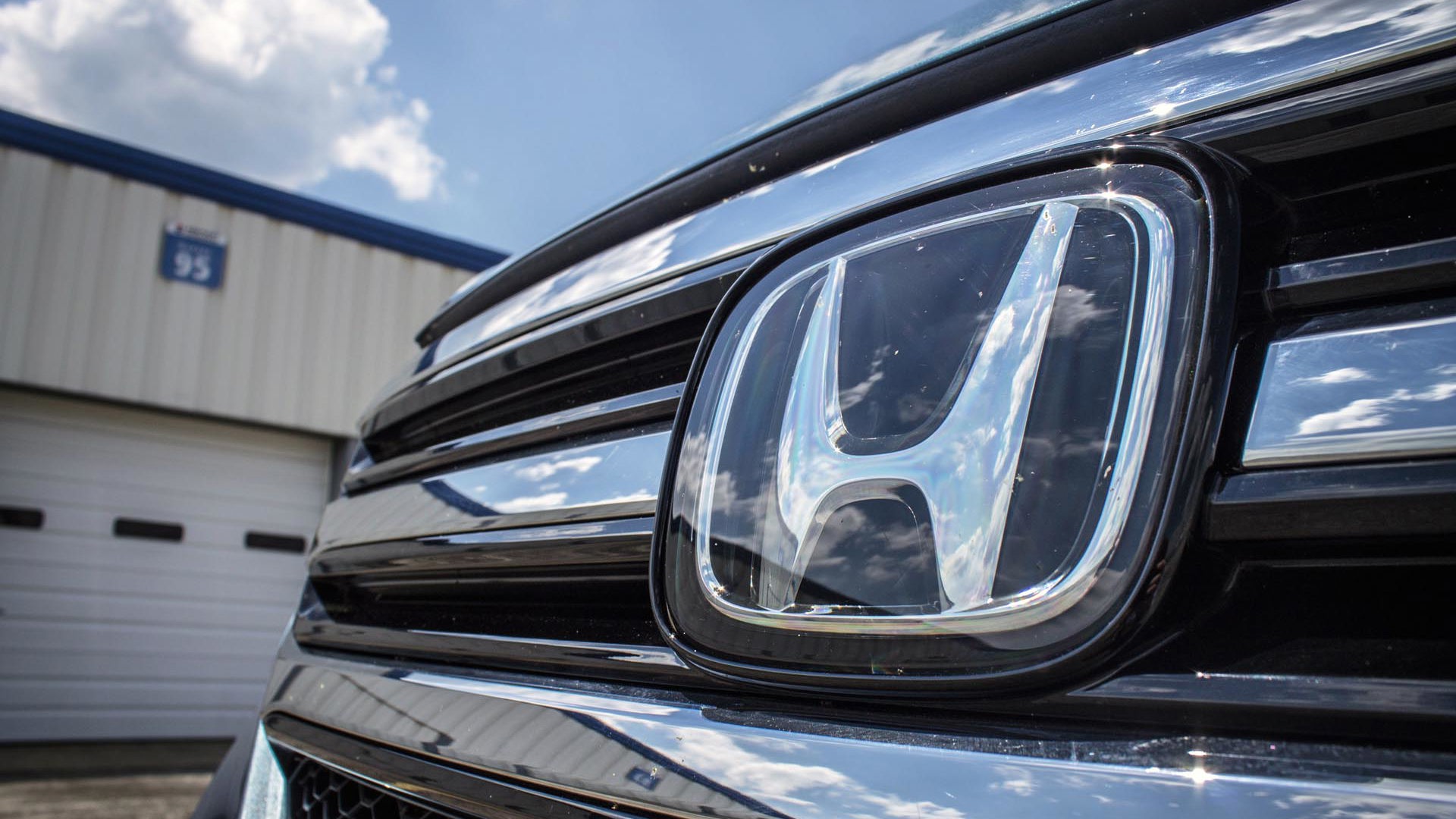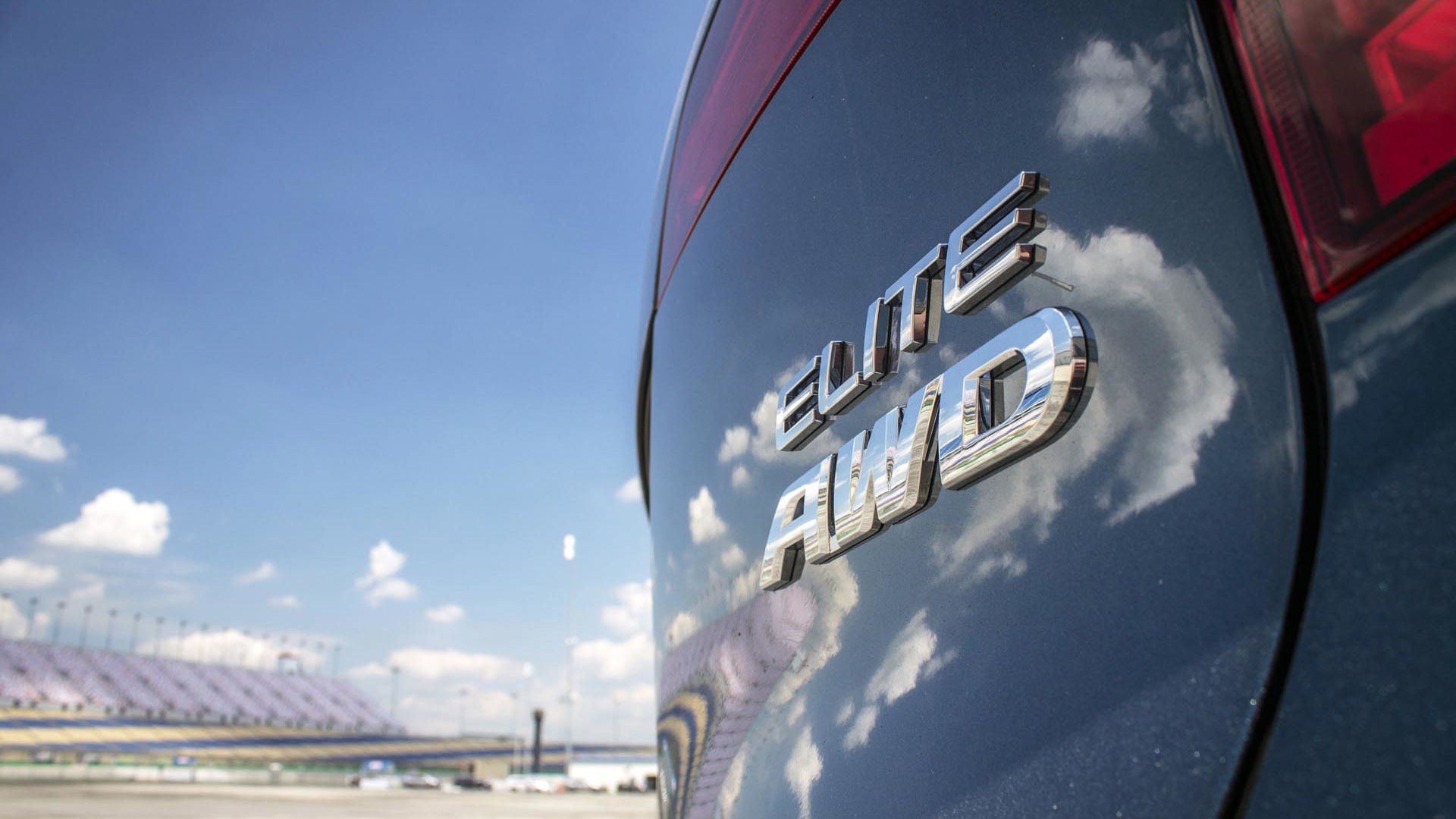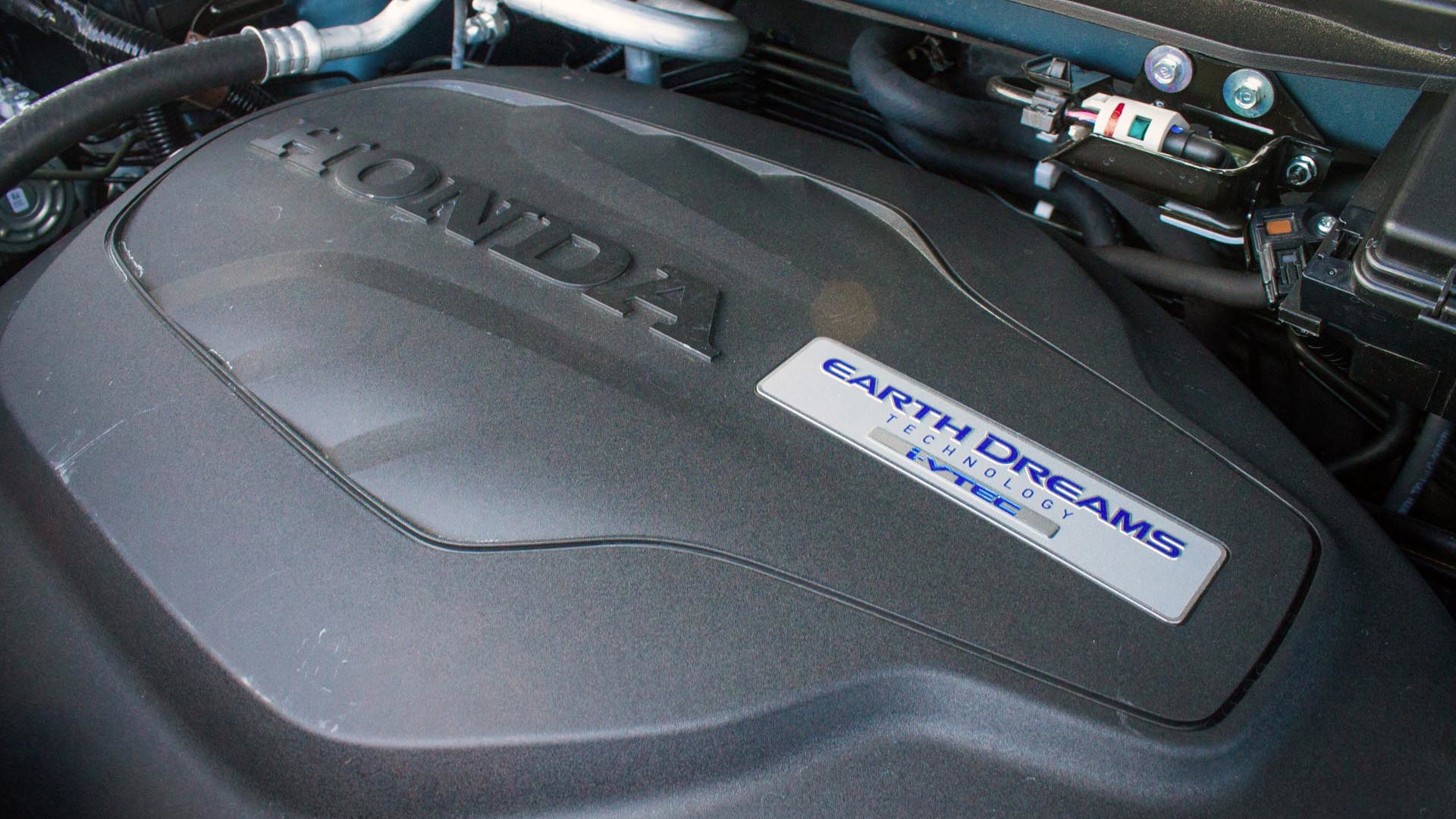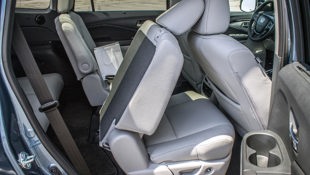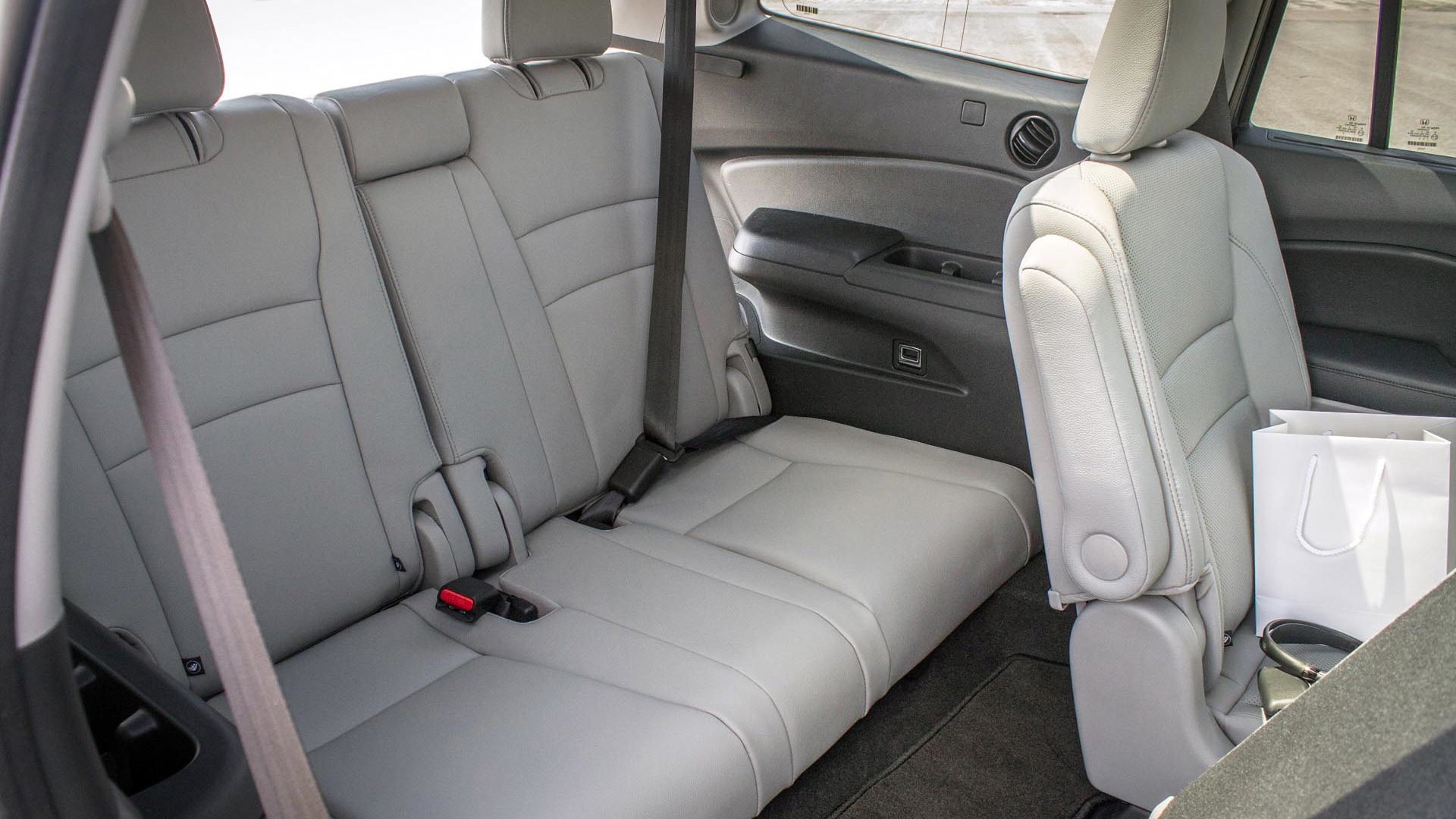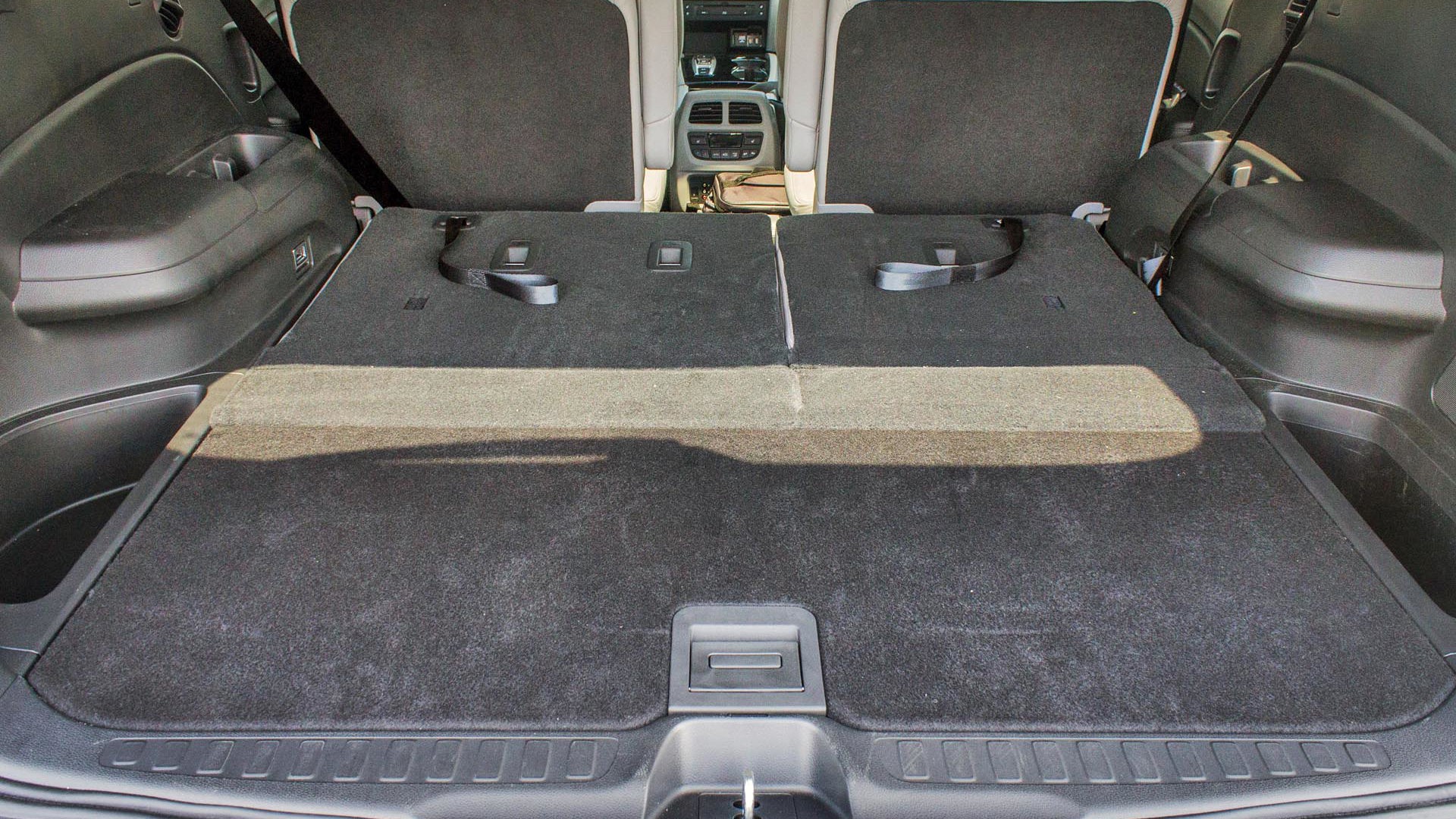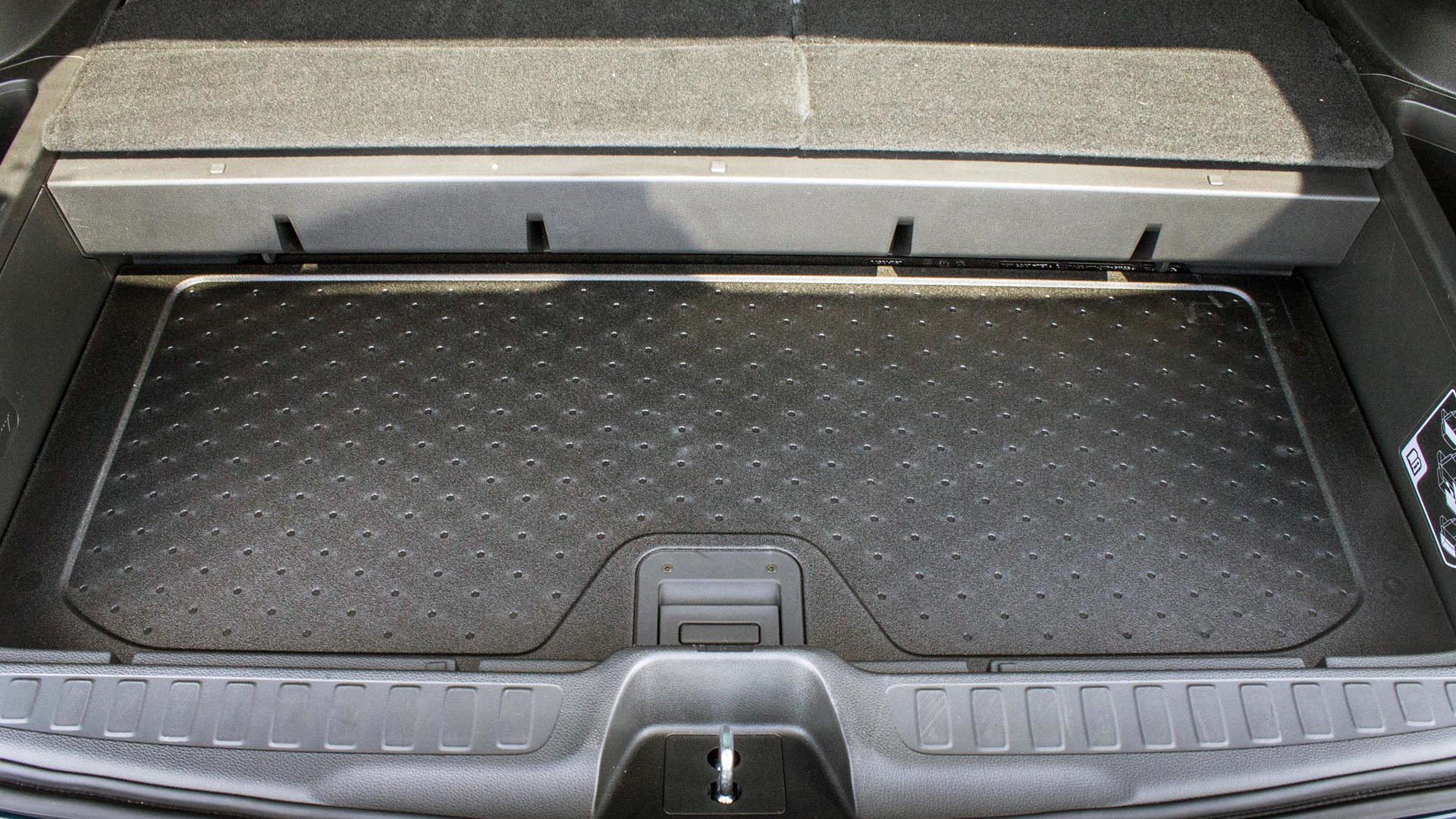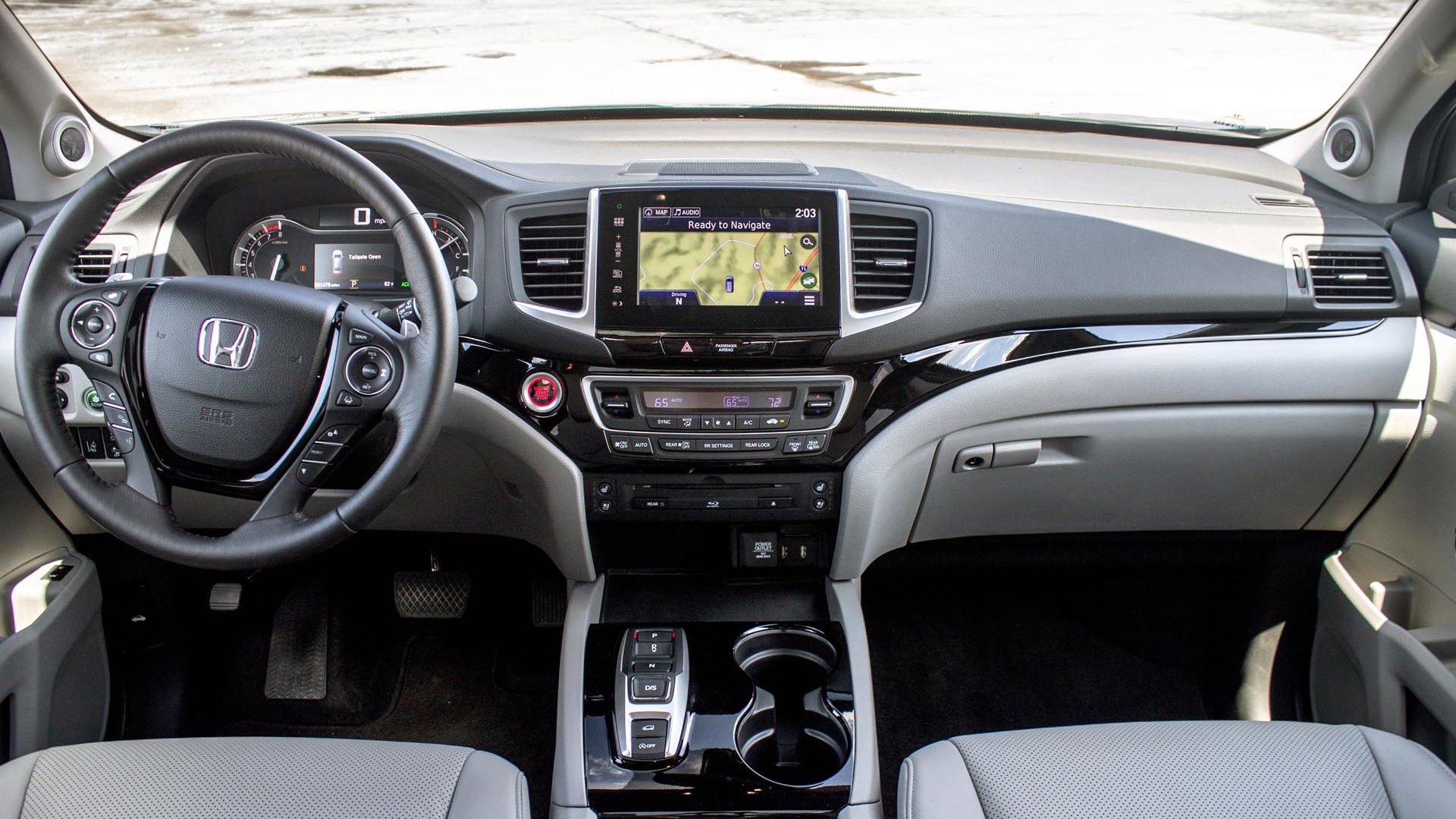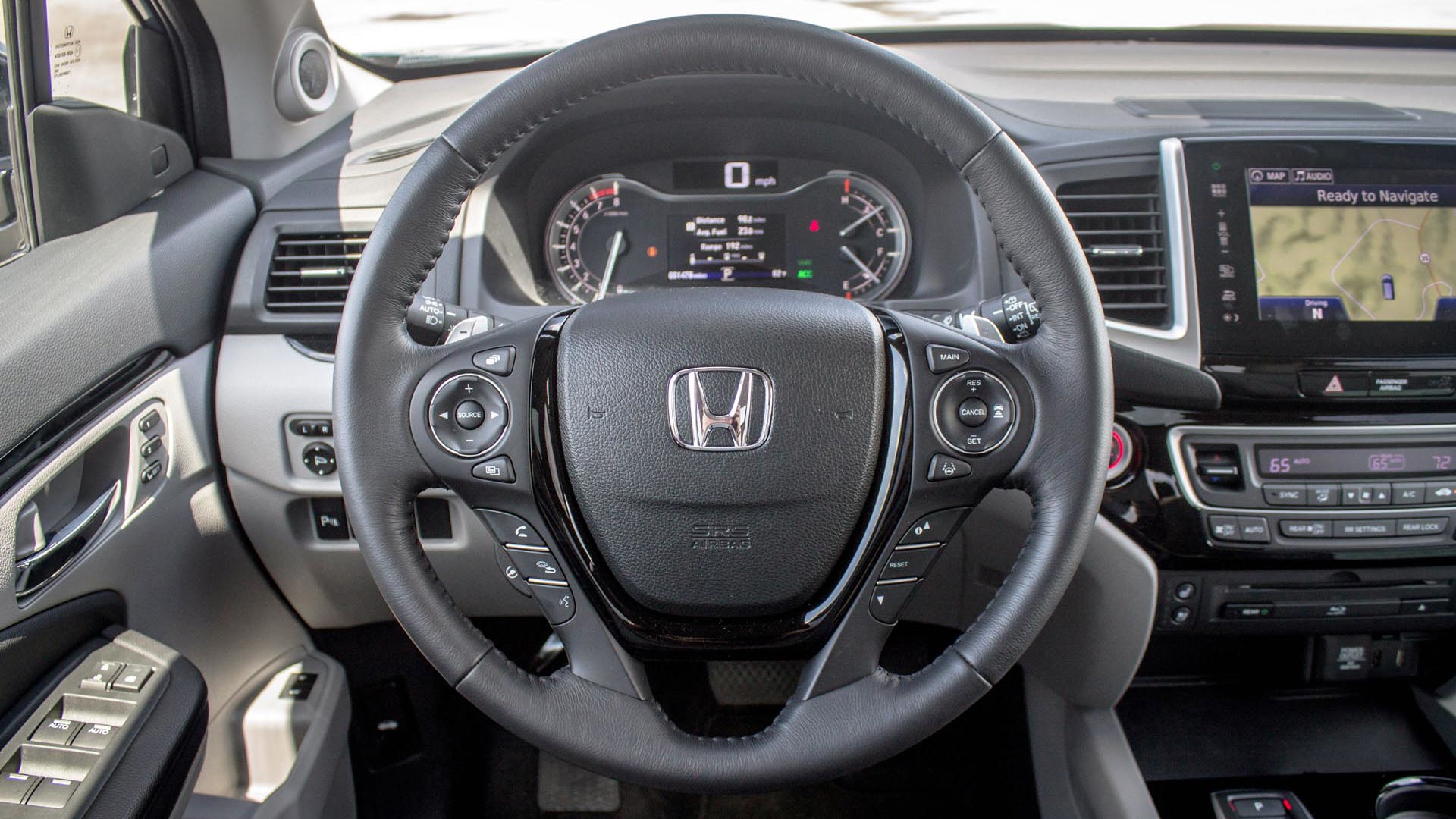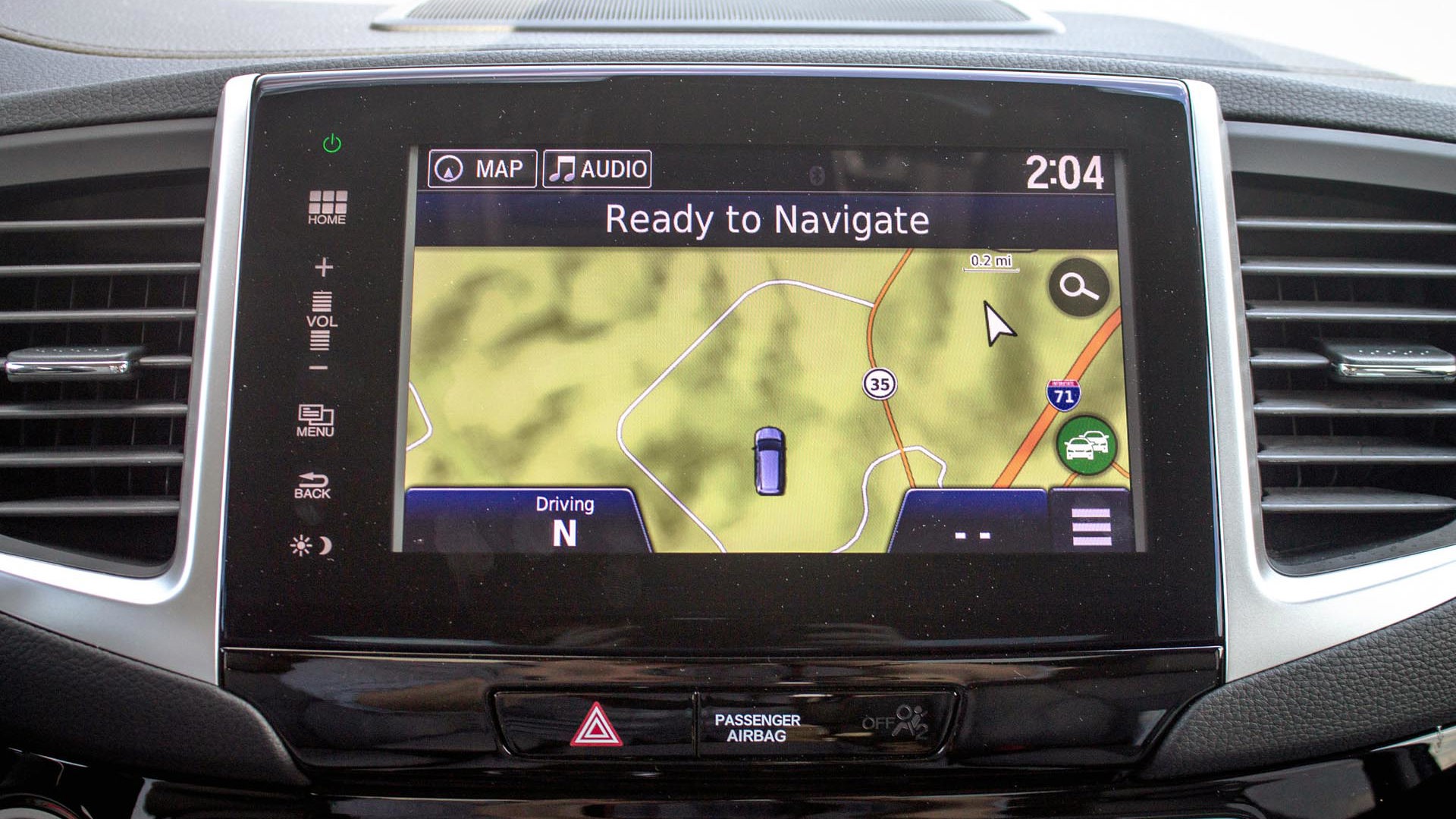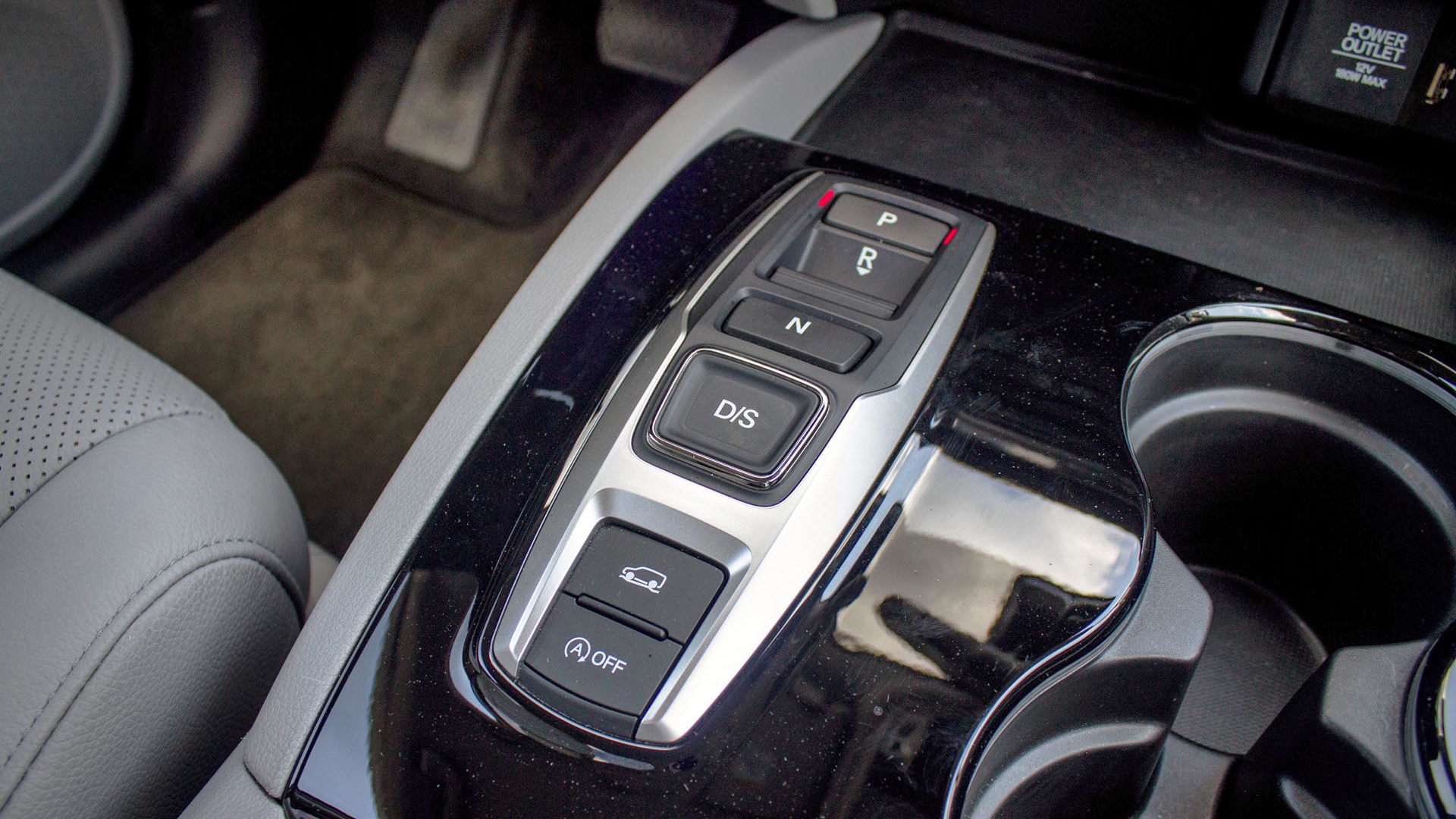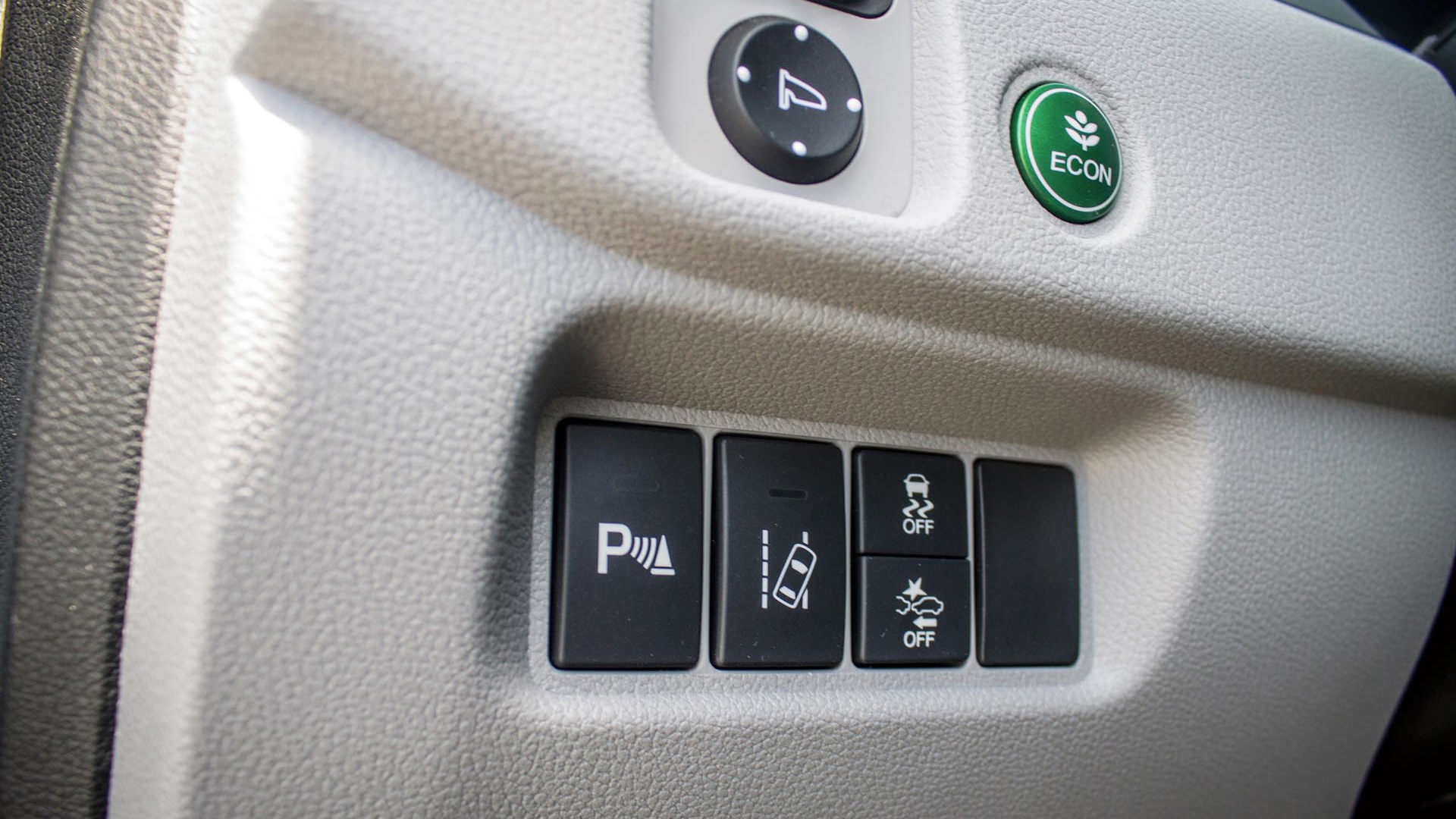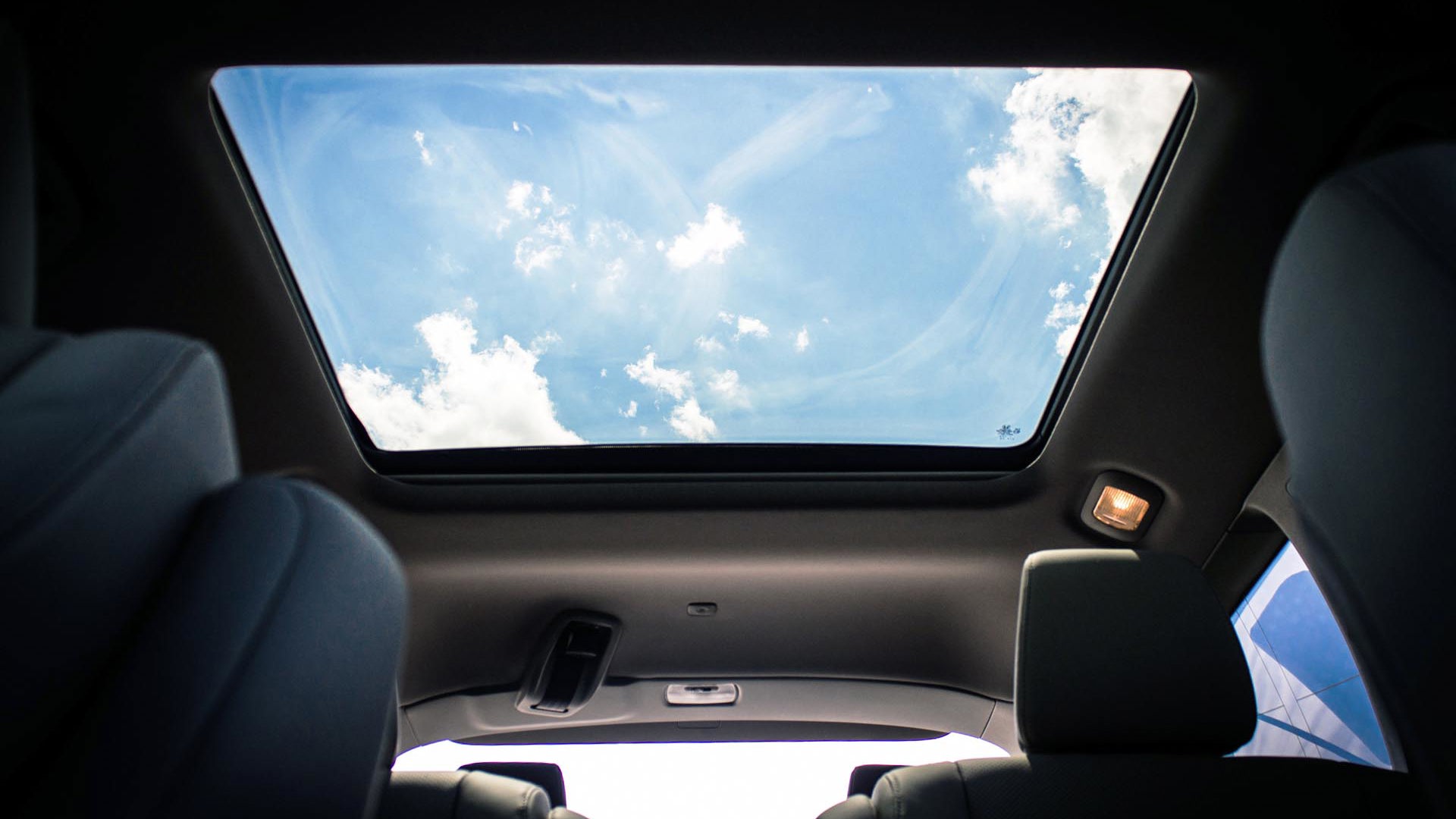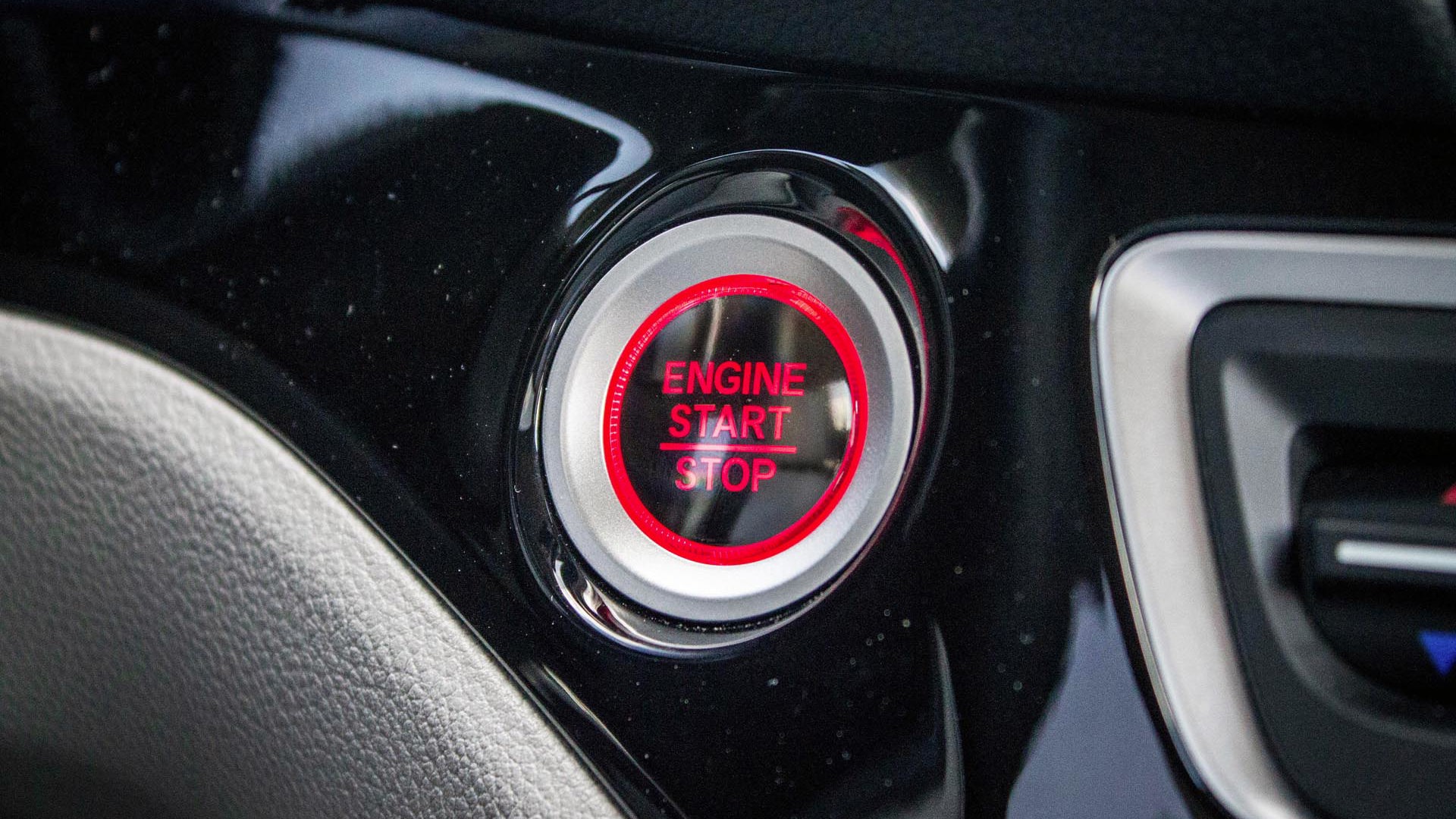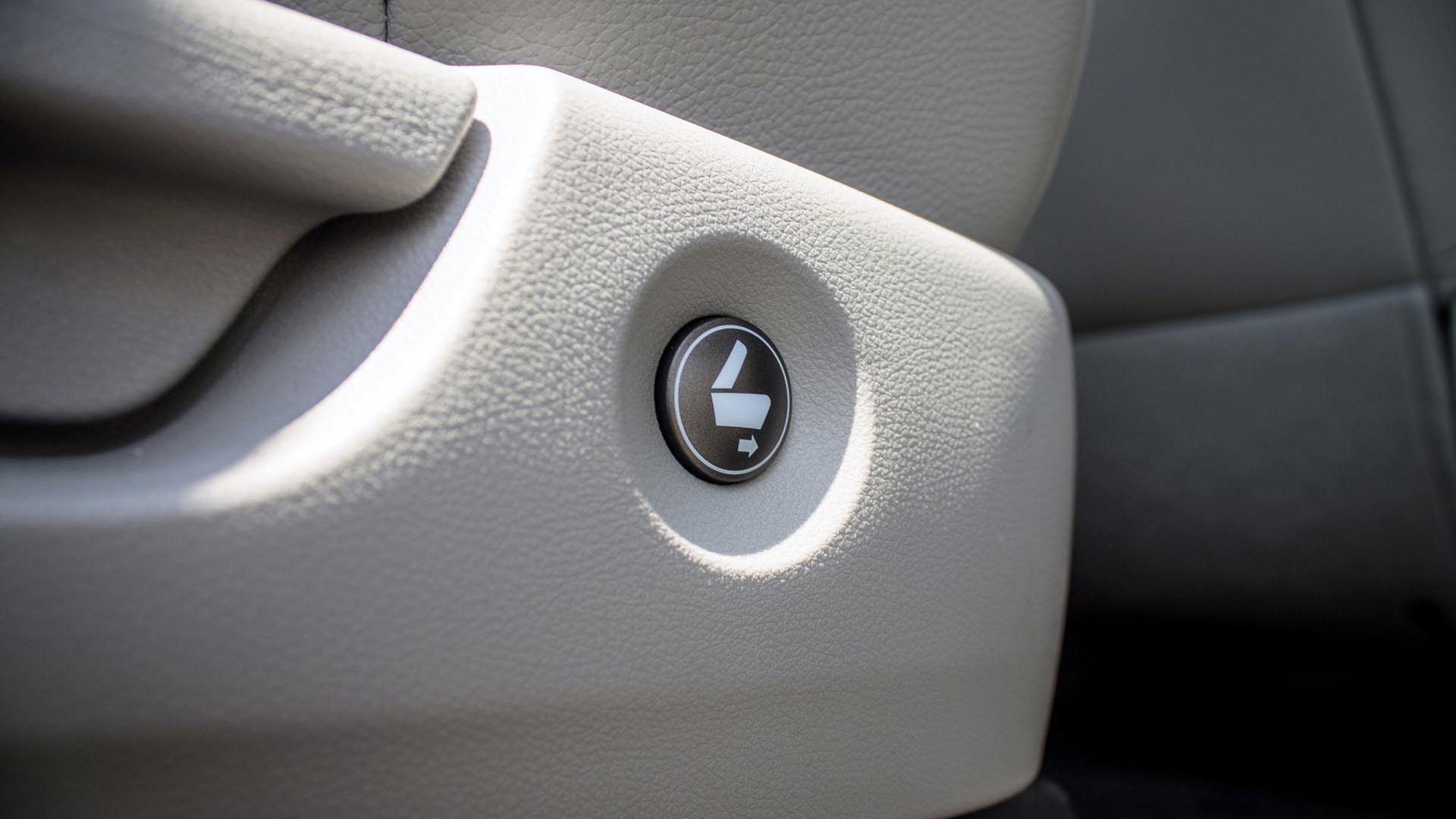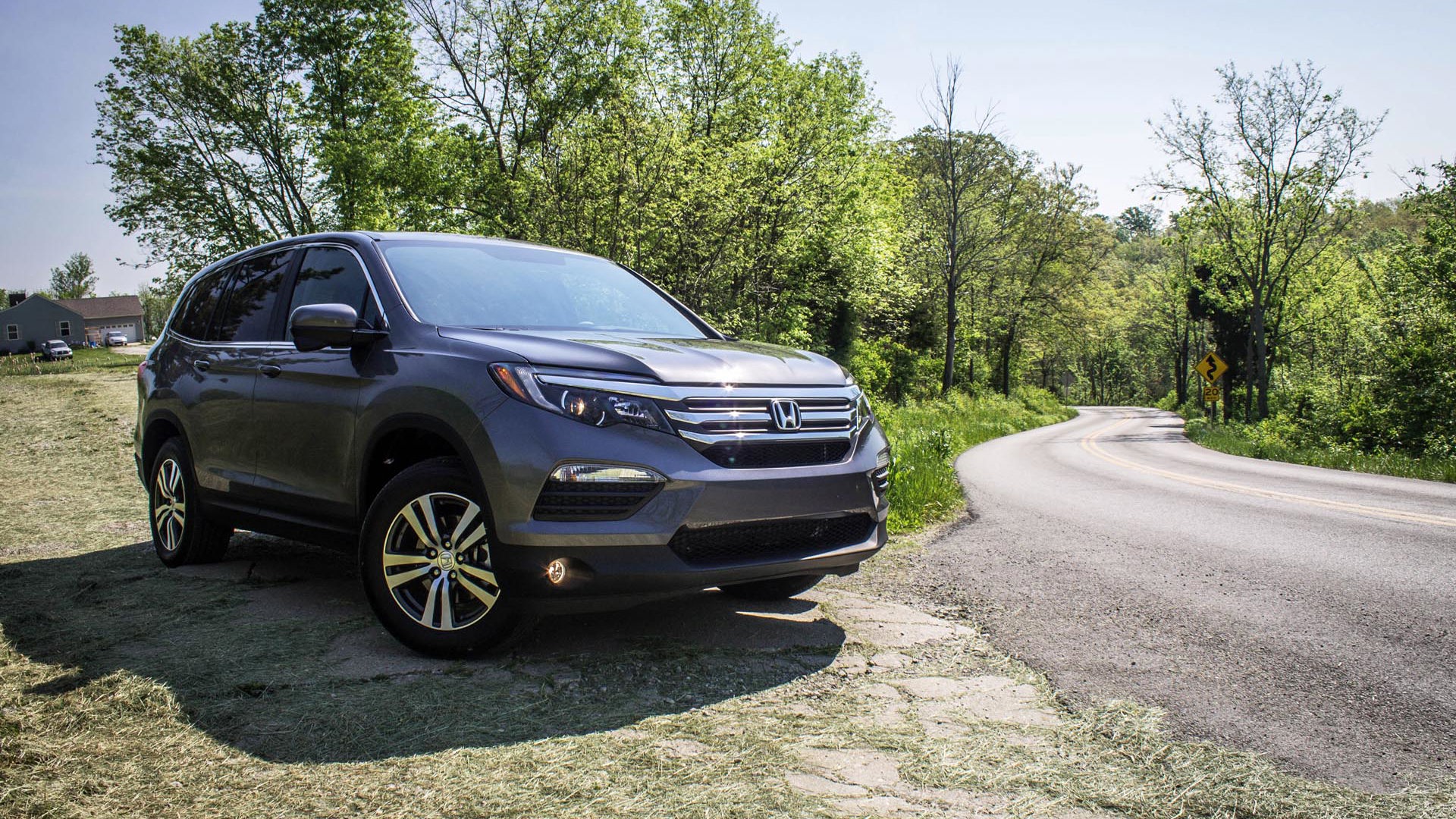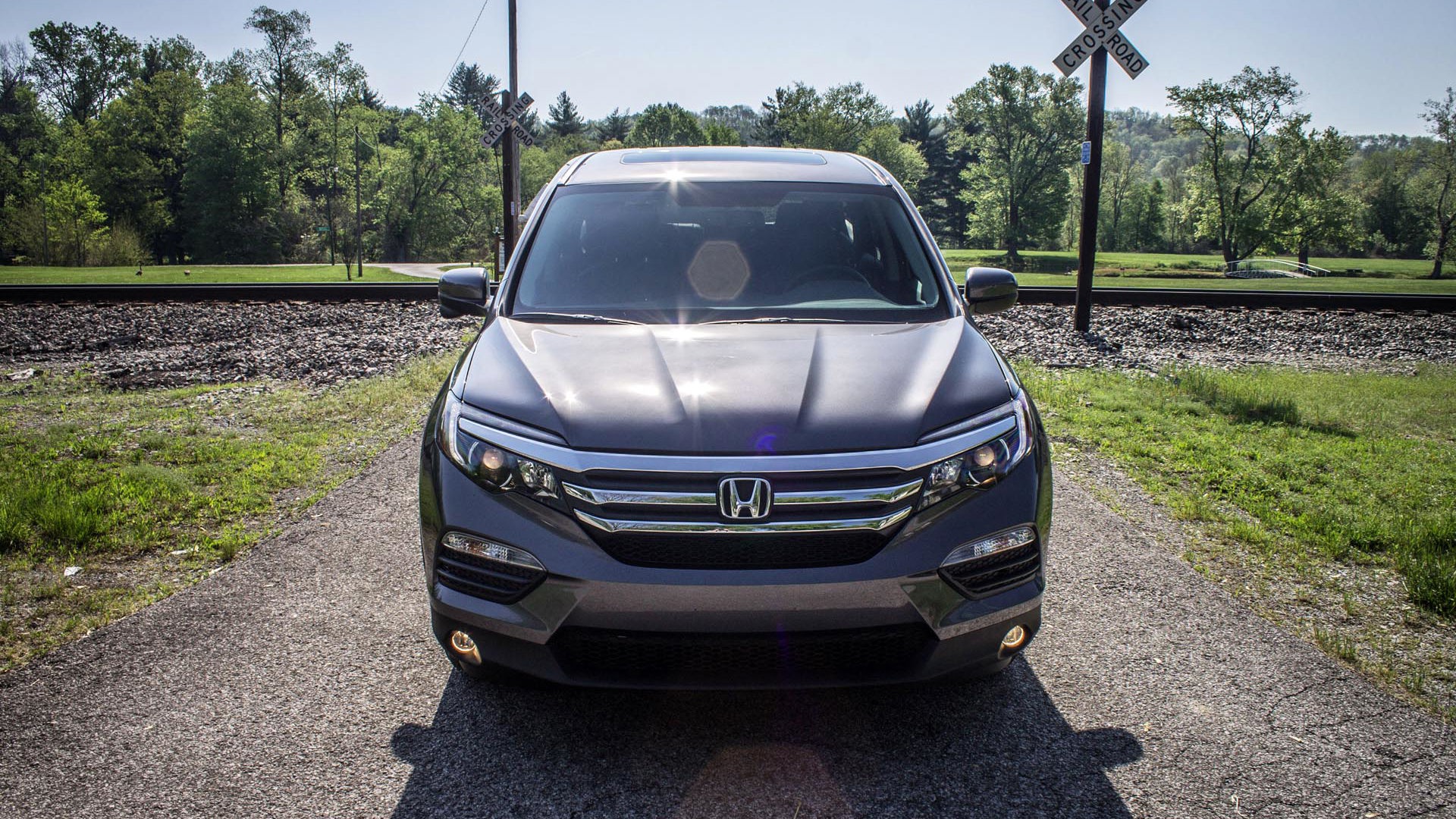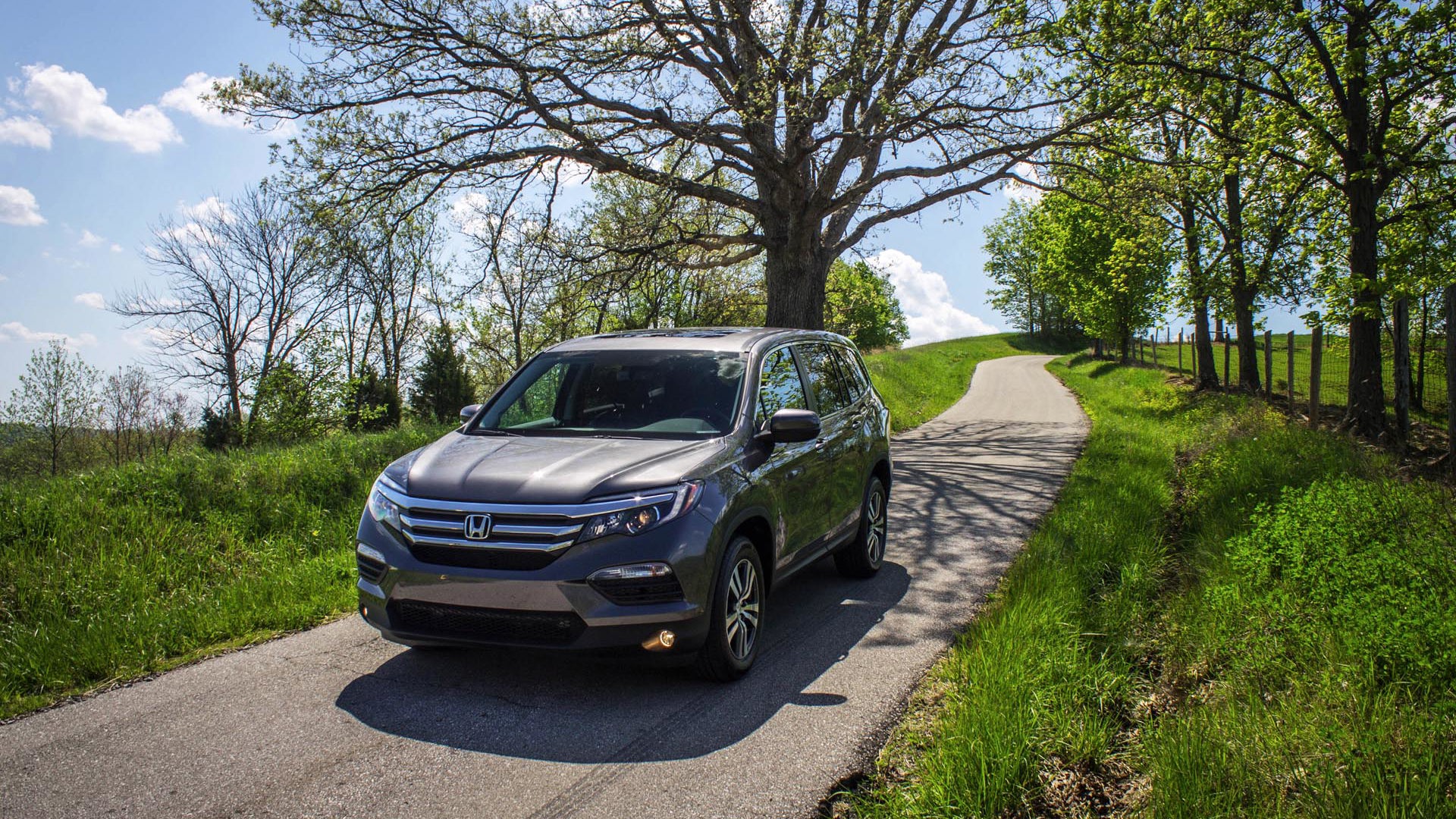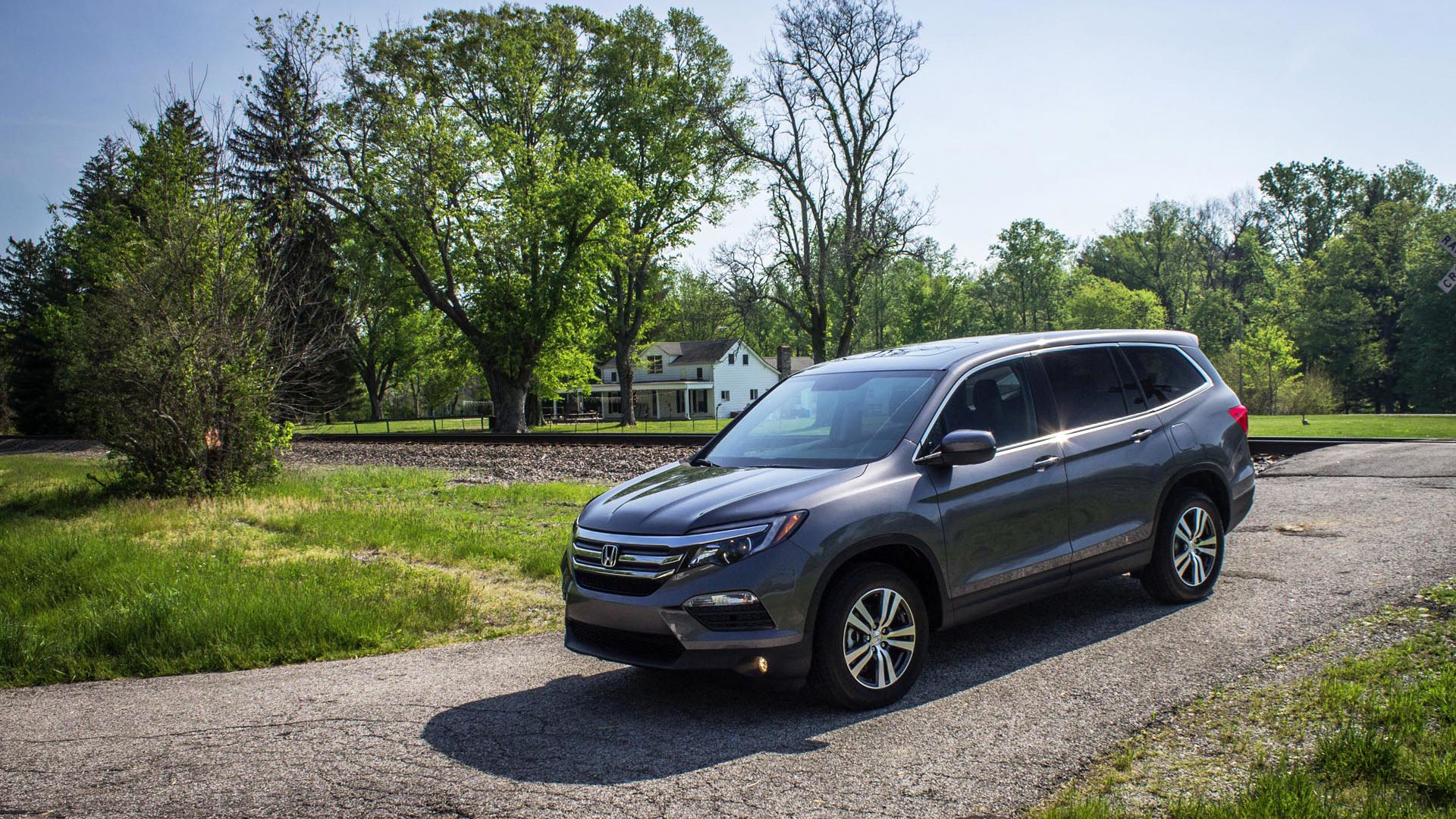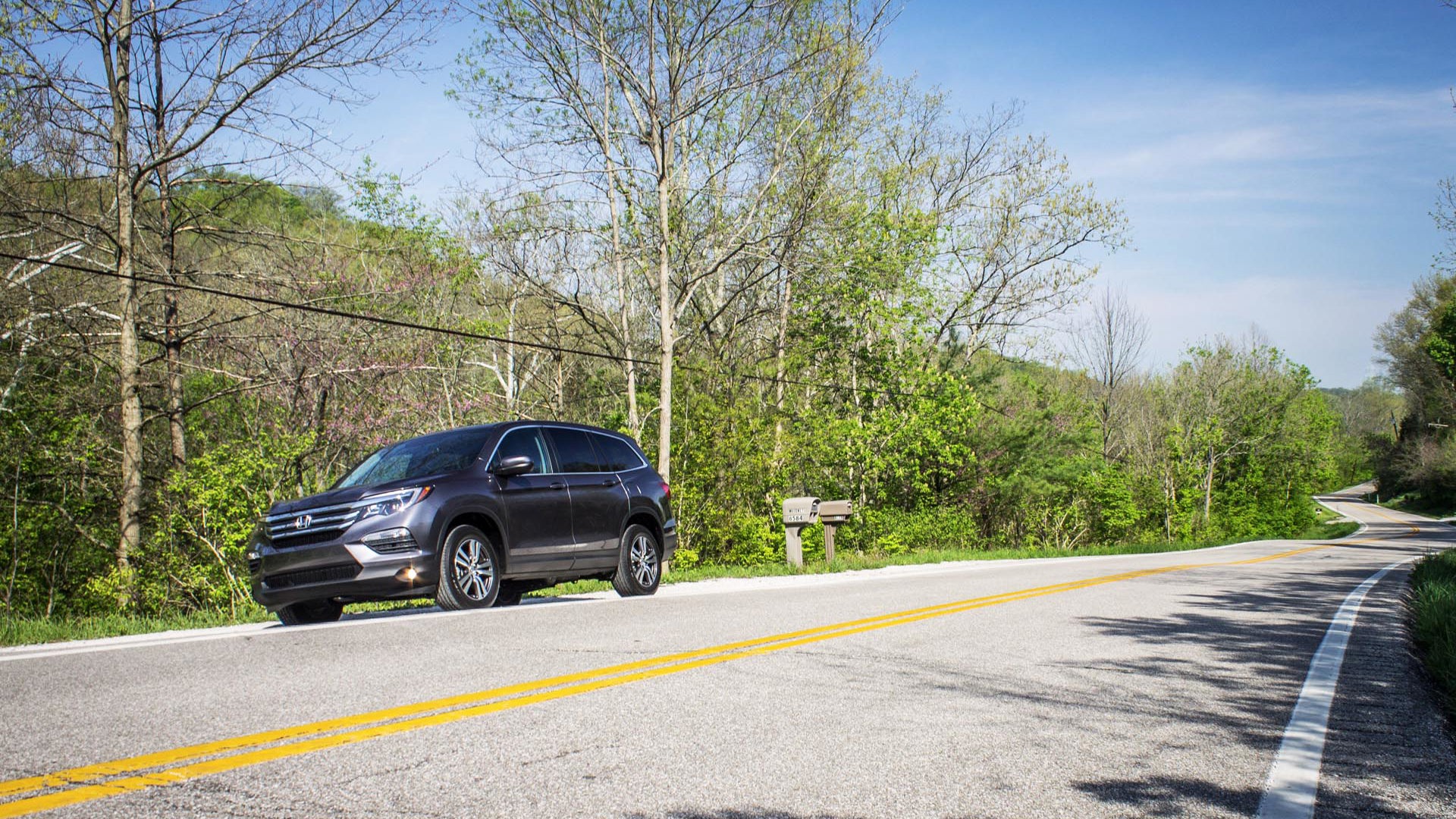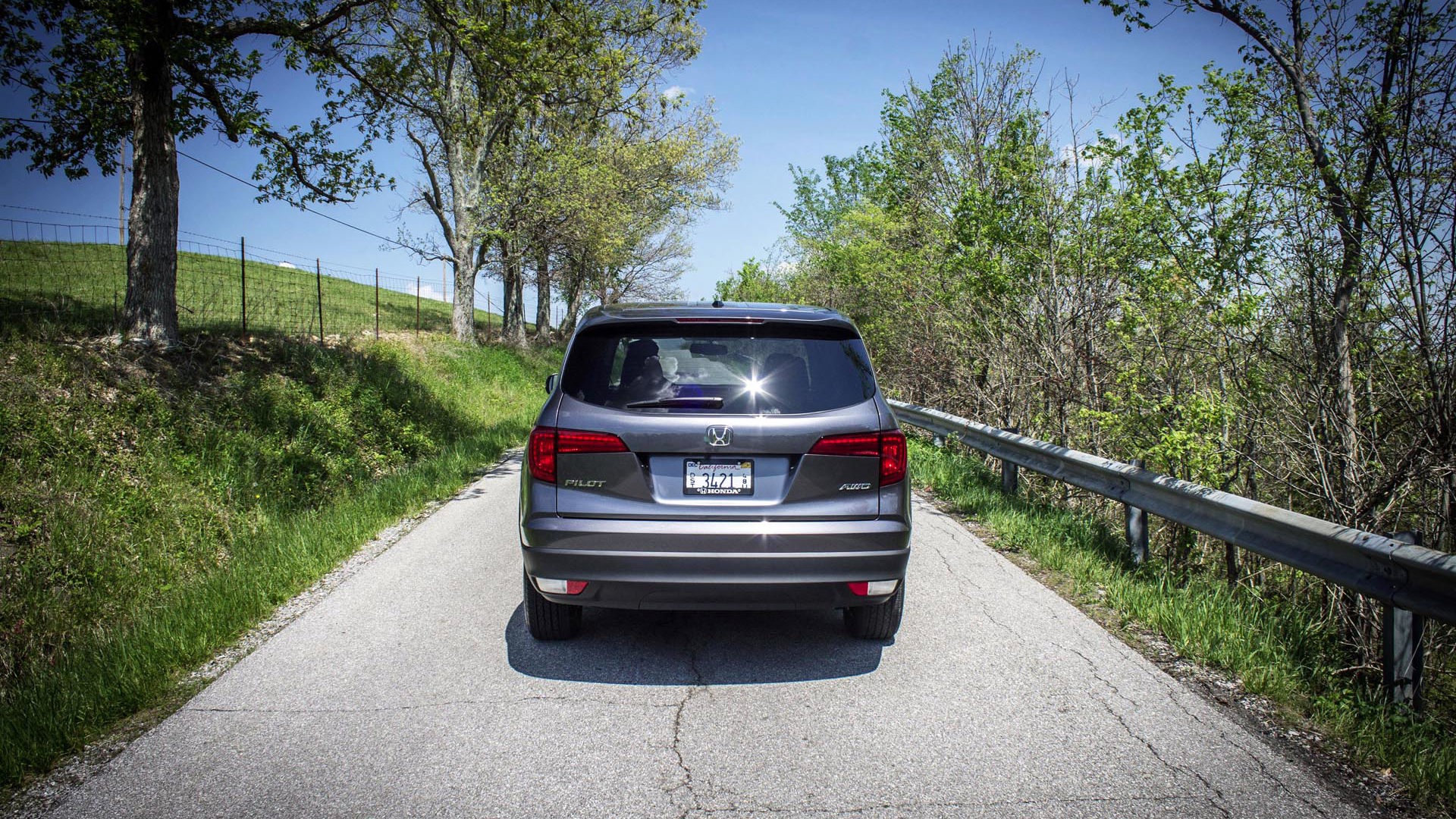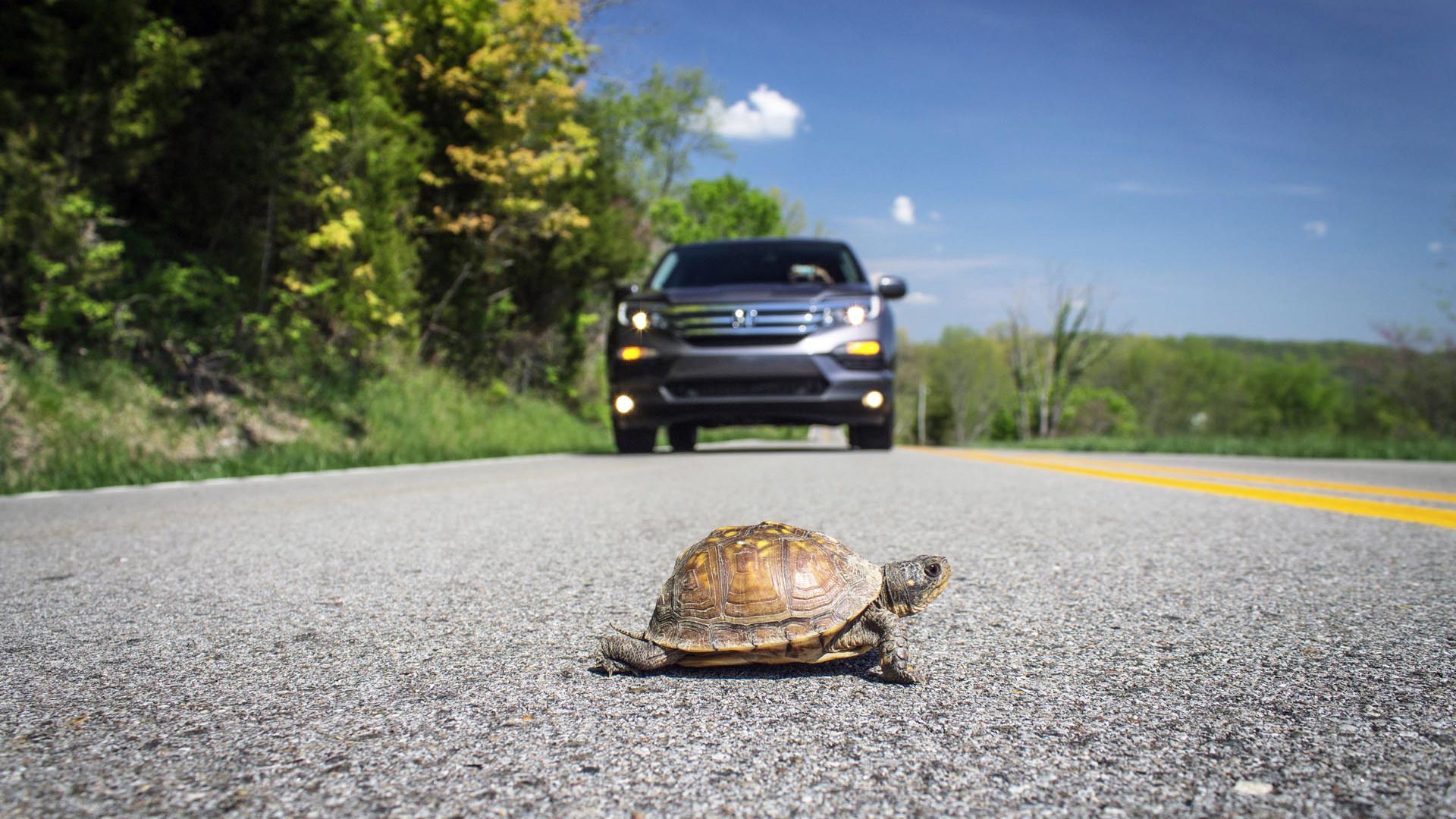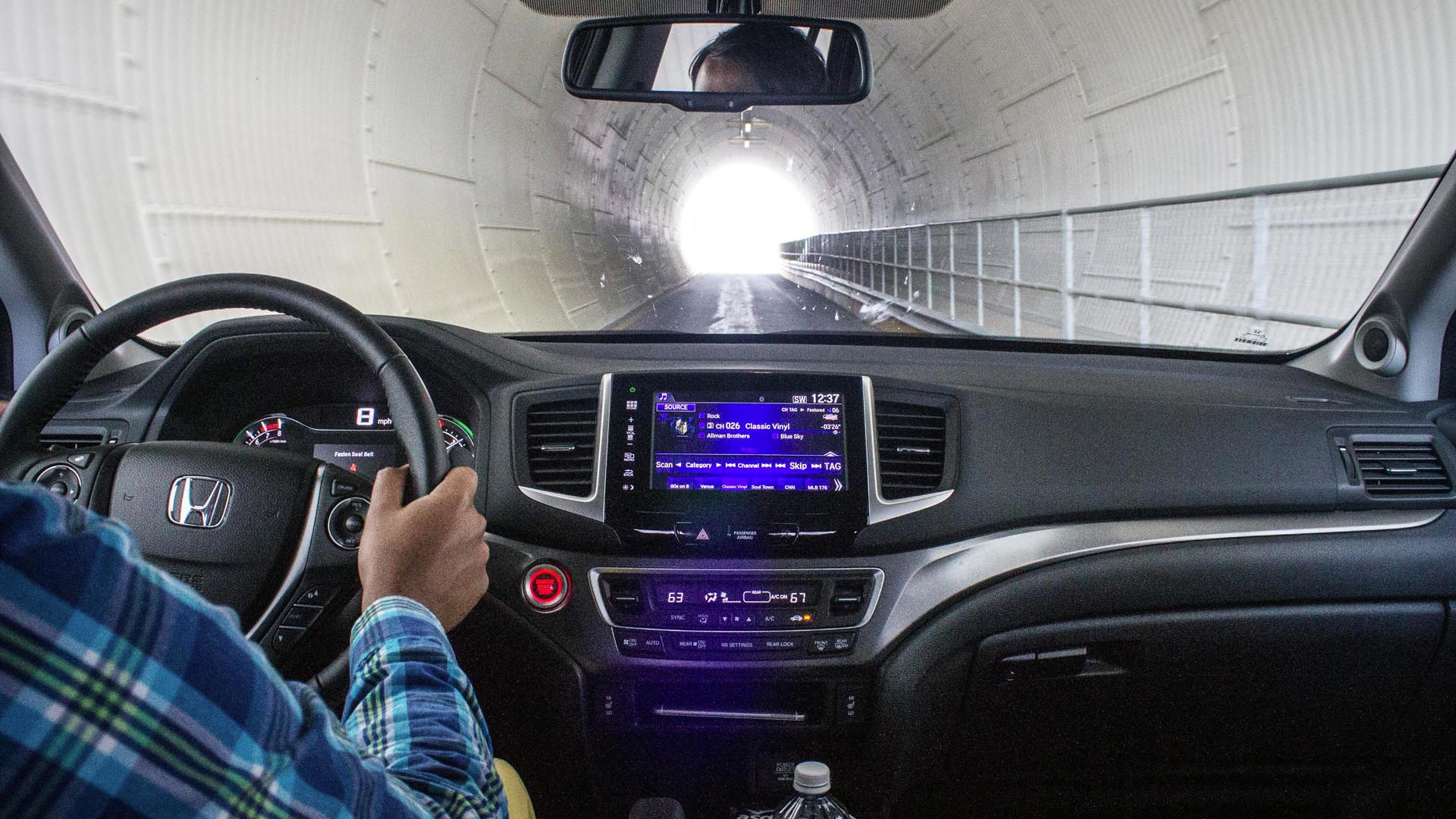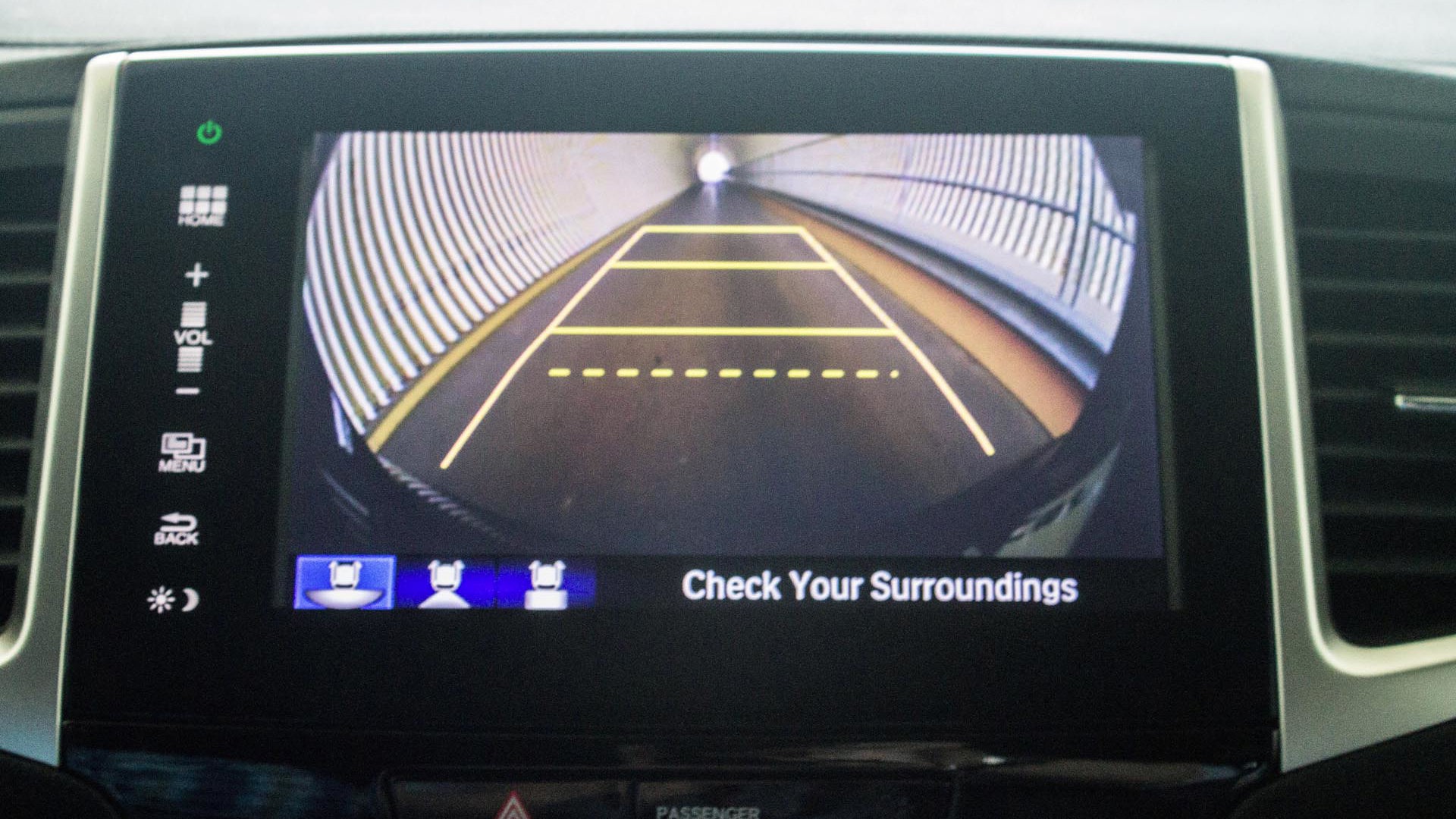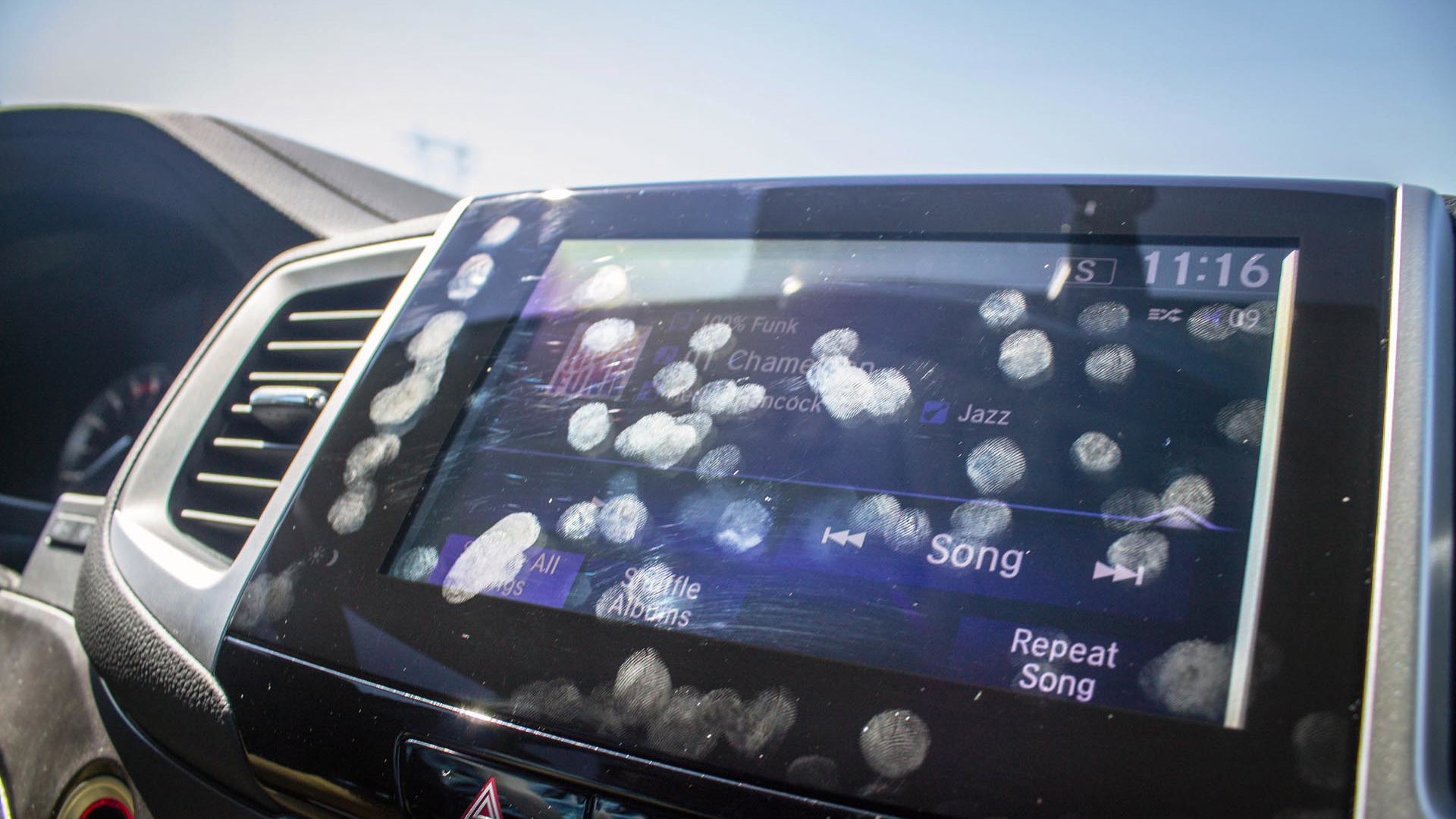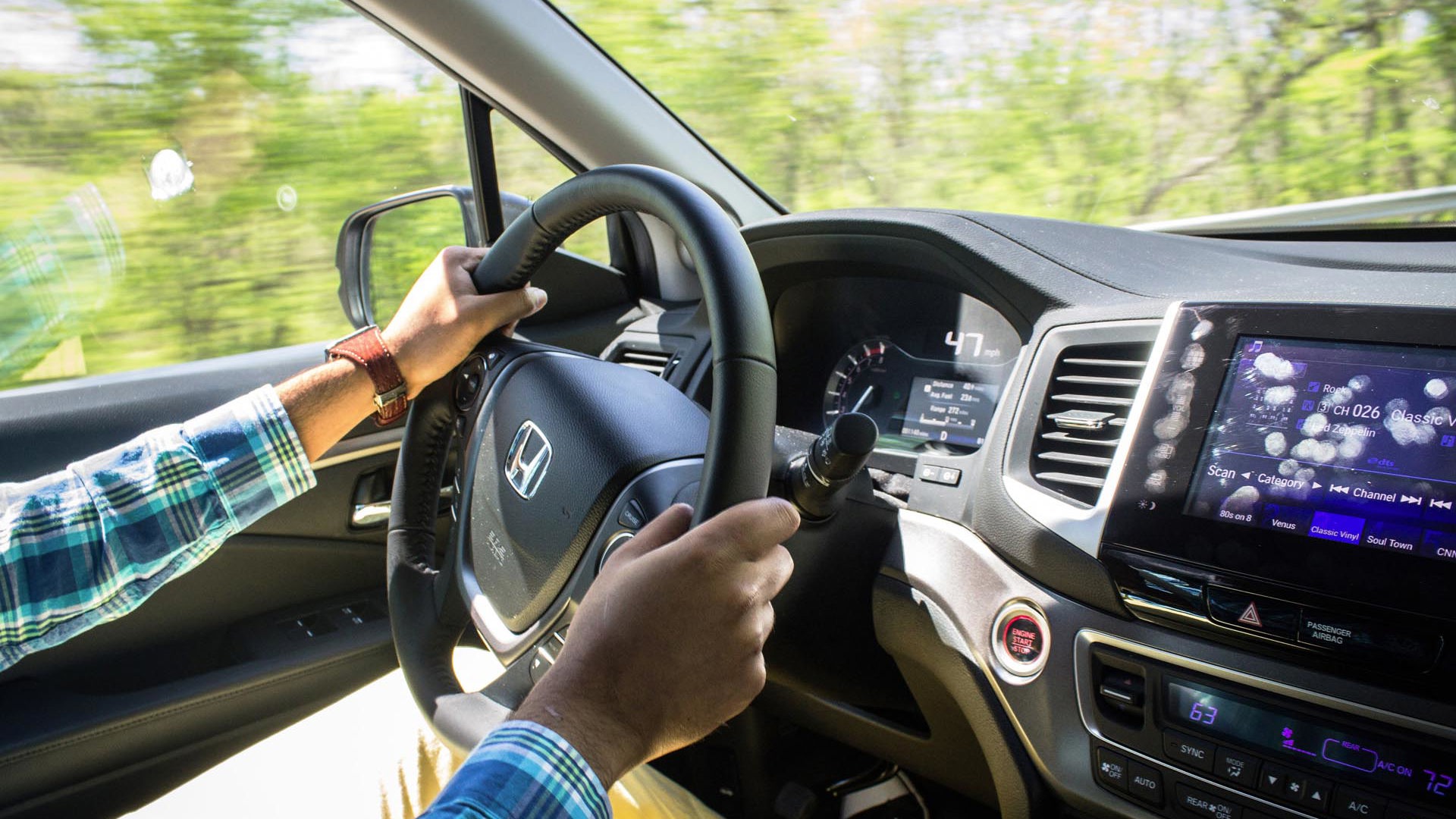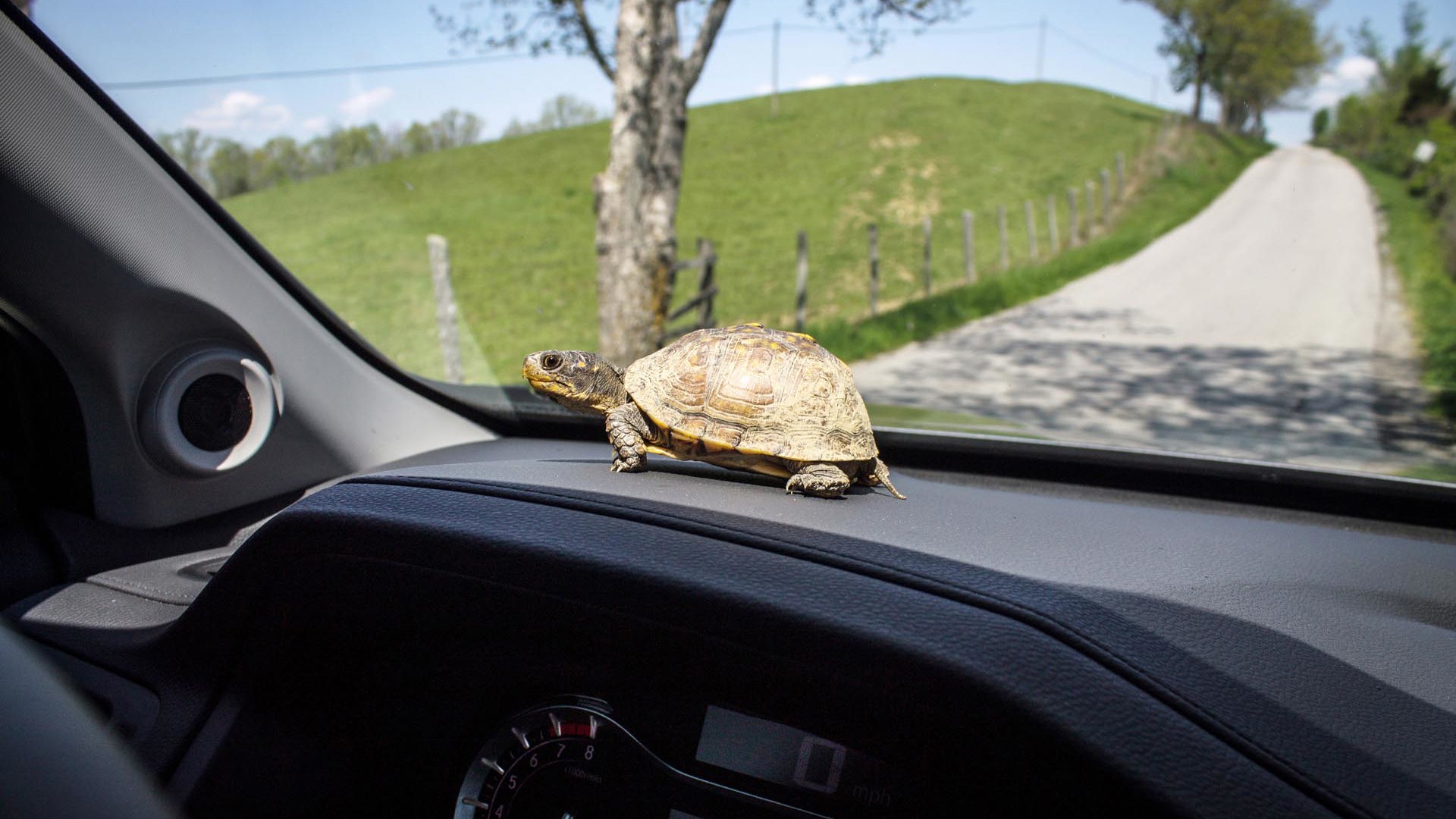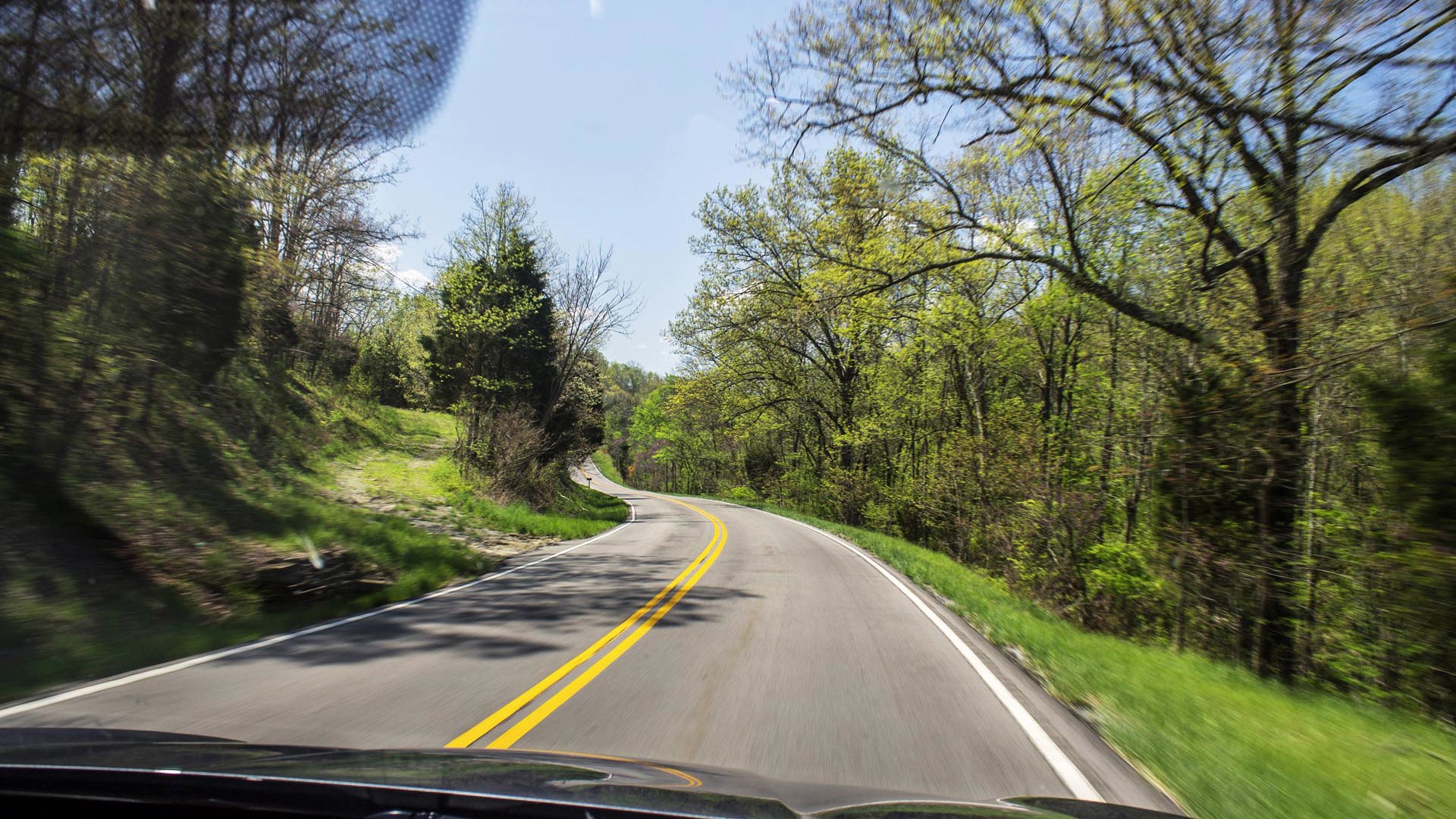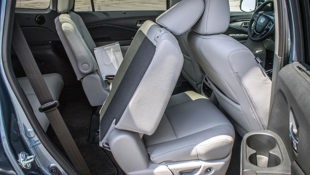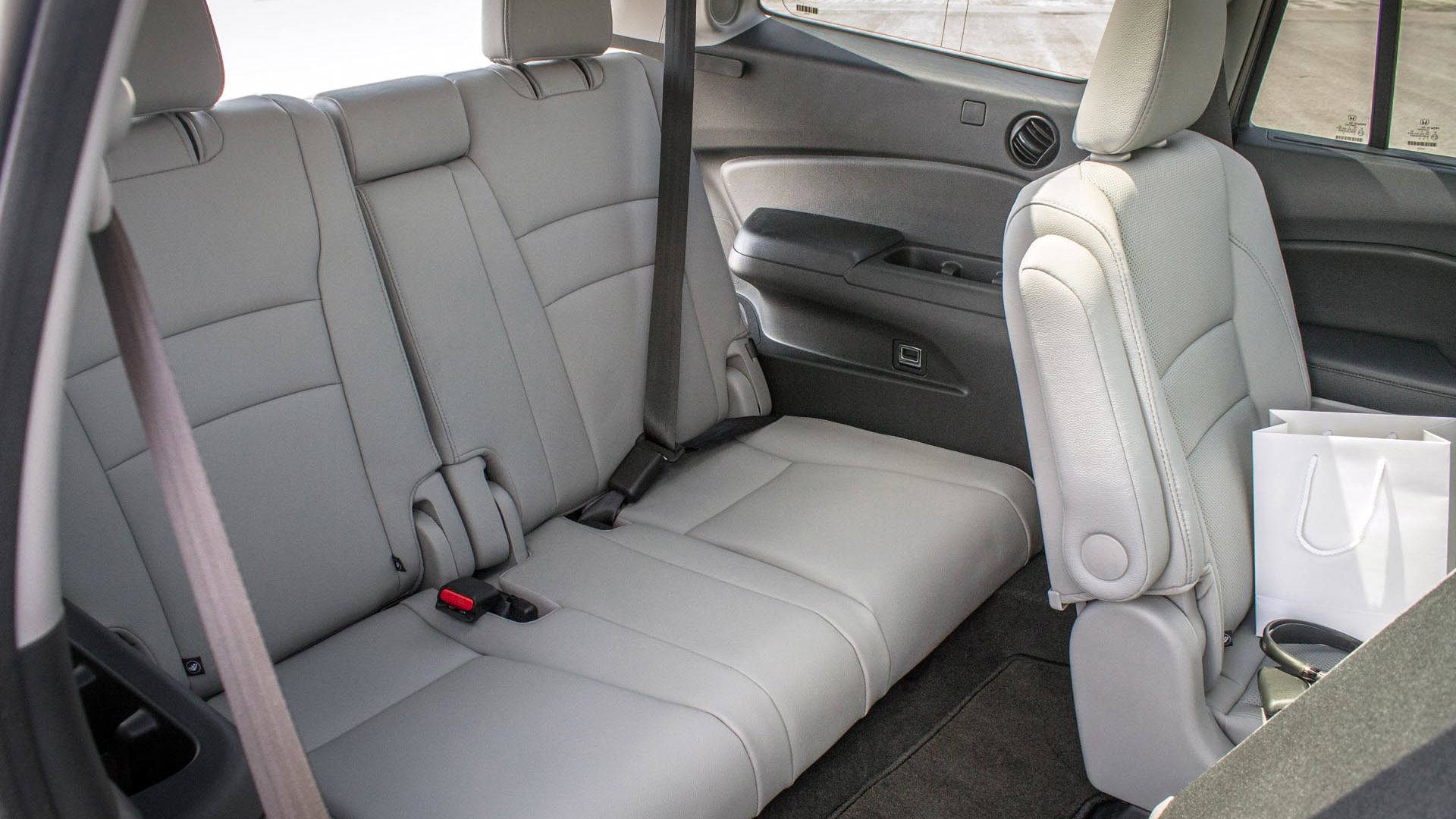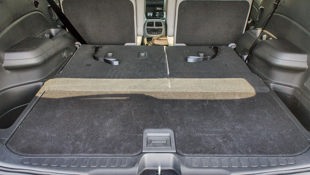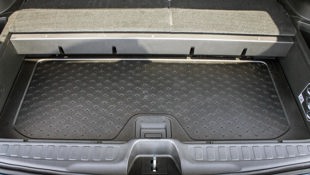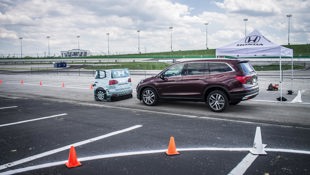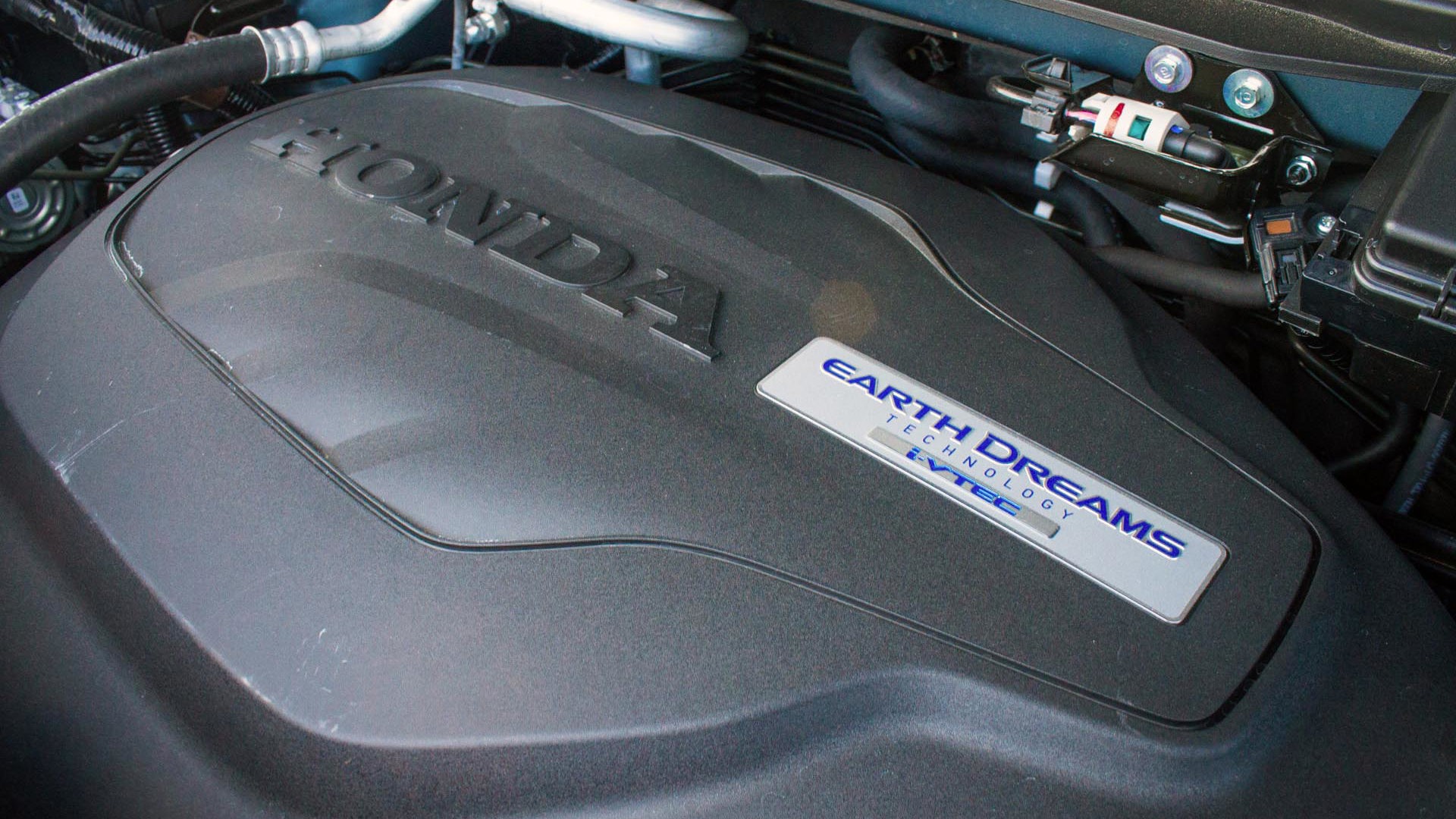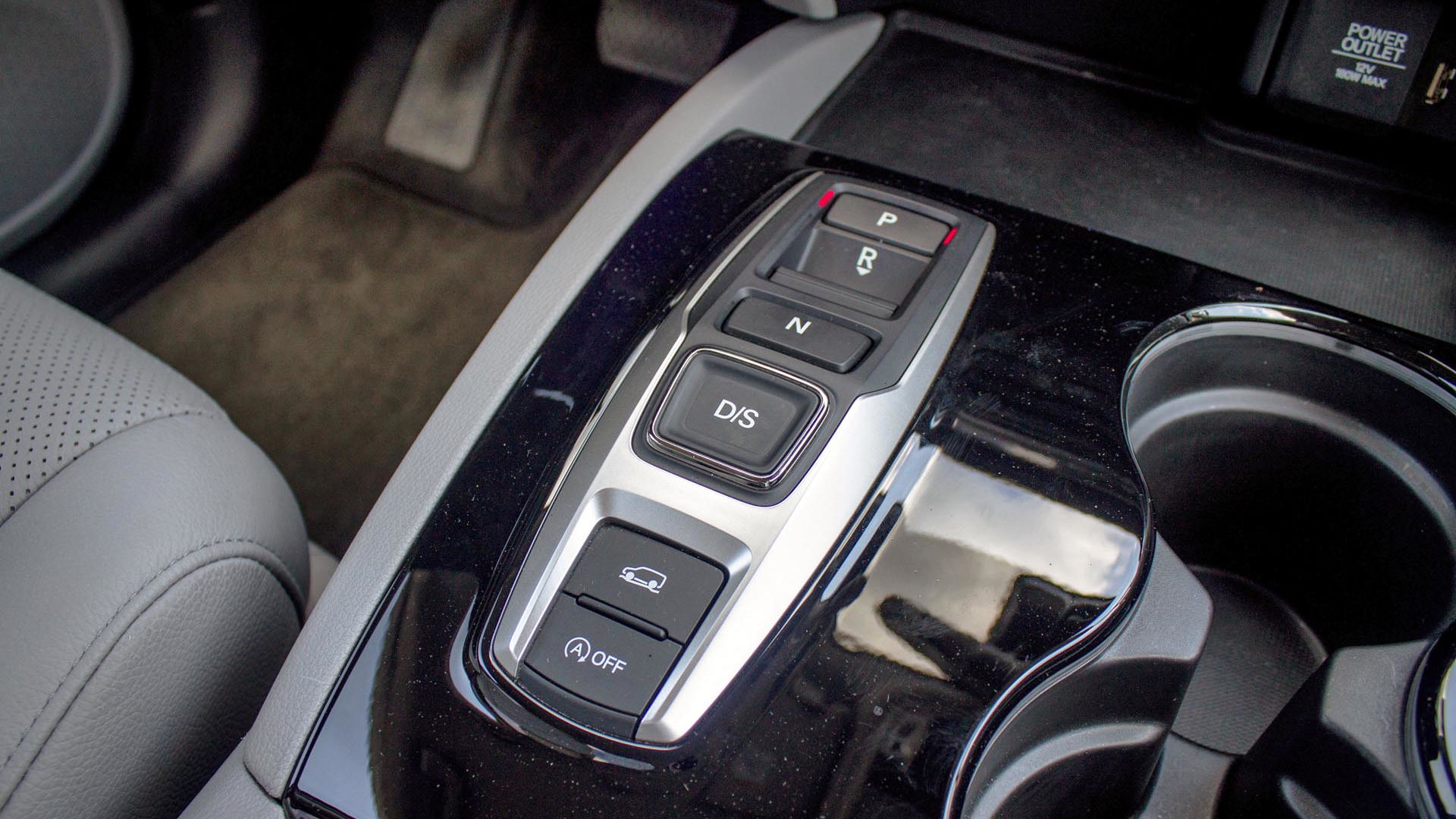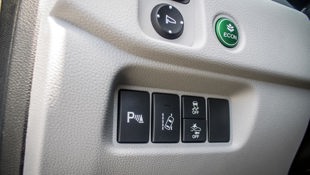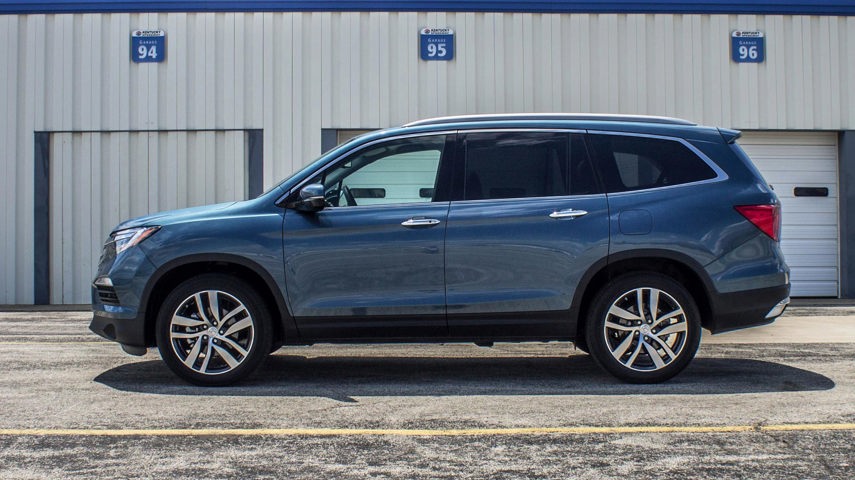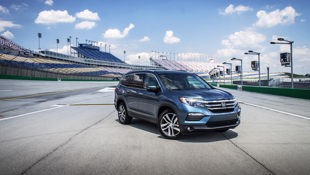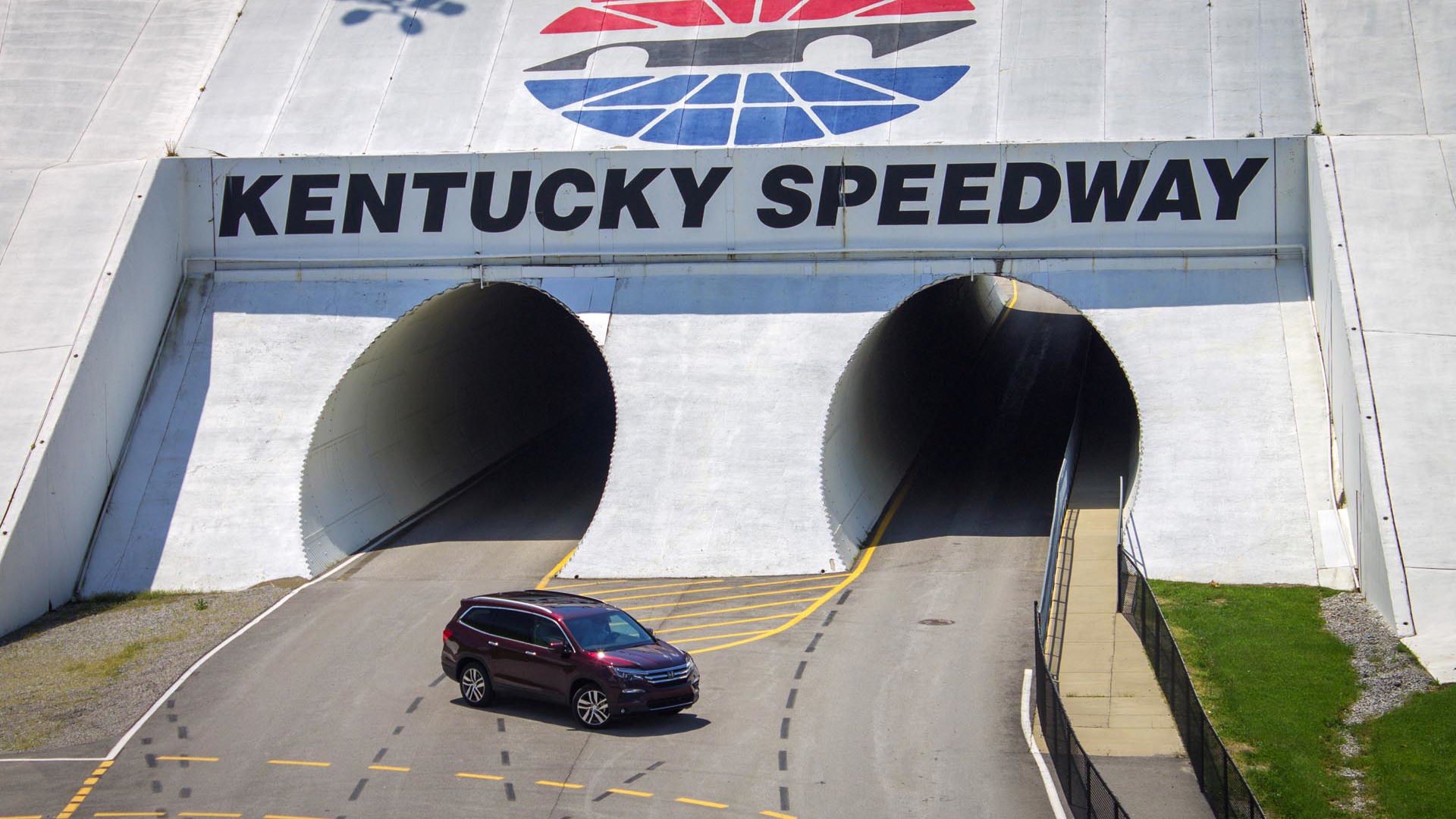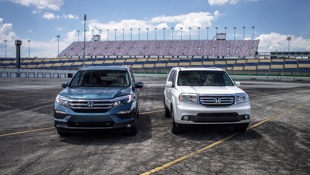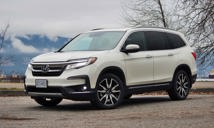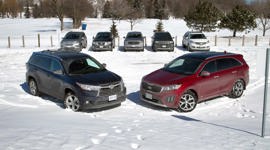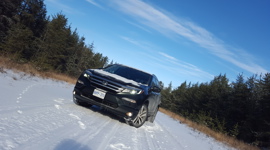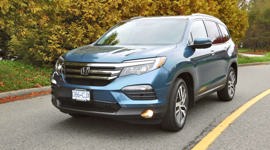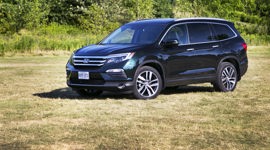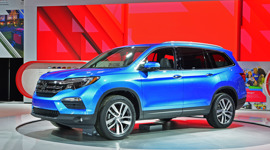Under a smothering Kentucky sun, our Honda heads West; smooth, glittering, reeking of turtle urine. But perhaps I should back up a little.
Meet the new 2016 Honda Pilot, a vehicle that may be best thought of as an unboxing video of the previous model. Among the usual marketing-speak at the product presentation, a slide is shown demonstrating what folks thought of the old car, and what the new one should evoke: for the former, a picture of a tank and a tortoise; for the latter, an eagle, a horse and the open road.
The new Pilot is 25 mm lower than the old version, 90 mm longer, and basically looks like it's been attacked by a belt-sander.
Or, alternatively, a bigger CR-V. This is a bigger CR-V: it's the same thing as a CR-V, except there's more of it. The new Pilot is 25 mm lower than the old version, 90 mm longer, and basically looks like it's been attacked by a belt-sander.
Honda's latest crossover cuts quite a likeable figure in its new flight suit. The LED accented headlights and taillights are standard, the three-bar front grille isn't gawp-mouthed or overwrought, and the side-profile of the greenhouse is simple and clean.
Eighteen-inch alloys are standard, but the car was clearly designed to wear the 20-inch alloys that come as part of the top-level Touring trim. Still, I'd rather have the 18s when it comes time to buy snow tires or replace the low-rolling-resistance three-seasons.
On the inside, the most has been made of that extra 90 mm to improve cabin space for all passengers. An Odyssey would still better suit a family of five with three kids in their teens, but the third row seat is actually manageable. The better news here is Honda's approach to making the Pilot friendly for younger offspring.
To fold and slide the middle-row seats, simply push a clearly marked (it also lights up at night) button on the seat bottom; after the briefest pause, the seat tilts forward and slides. The ingress/egress gap isn't as good as in the Pathfinder's double-folding seat, but should be fine for tweens.
What about stuff? As with many three-rowers, deploy all the seats and cargo space drops to sub-hatchback levels. However, the Pilot comes with a repositionable rear floor that creates a little extra space – it's a two-sided affair, so you can flip it to carpet so stuff doesn't slide around as much, or to hard plastic for soccer cleats and whatnot. Cargo area is 524 L with all seats up, 1,583 L with the third-row folded, and 3,092 L with all seats down in finally-the-kids-are-off-to-college mode.
Up front, the Pilot does its best to please those who actually paid for the damn thing. It does so relatively well, although the initial impression is of typically cautious Honda design. For instance, while the centre console has a flat sliding lid on a bin that's large enough to sublet to help make the finance payments, there's no clever storage shelf like you find in the Highlander. Nor, it has to be said, is the Pilot's interior immediately as upscale in appearance as the Toyota's. The seats feel harder, and there are no daring details.
It is “nice” though. Everything feels typically durable, and as for the ability to keep everything clean of the flotsam and jetsam of family life, well, let the record show that turtle pee wipes right off.
And speaking of ammonia and wiping, let's discuss the central touchscreen that controls the Pilot's infotainment functions. This 8-inch screen is large, bright, glossy, and it now reacts quickly to touch. There is some fussiness in where submenus are buried (changing the audio levels, for instance, requires lots of button pressing), and there's no volume-knob, but overall, it's a very good system. The speed of reaction and quality of resolution is impressive enough to wow showroom buyers, and appears to be easy enough to live with once you get home.
However, ten button presses in the hot Kentucky sunshine and it's an absolute smudge-a-geddon. This is a common problem with many touchscreens, but Honda's shiny surfacing material and screen-angle seems particularly prone to marks. If you're a neat-freak, this could be a constant eyesore.
The 225-watt stereo in the LX, EX, and EX-L cars is adequate, no more. No one will be displeased by it, but audiophiles will want to move up to the Touring trim for more premium audio. Bluetooth streaming music functions and iPhone connectivity functions worked without issue, and Honda still supports XM with a number of unique features, like the ability to mix channels between several of your favourites.
Satellite navigation looks better simply because the resolution is up, and guided us without misstep through Cincinnati's ripped-up city roads. I'd like a little more time to throw a few construction-slowdown curveballs at this to see how it does, but the 3D maps are a nice touch, and we should see real-time traffic updating and rerouting soon in Canada. However, Honda restricts their navigation to the top-trim Touring; a mistake, perhaps, when you can option sat-nav in a sub-40K Pathfinder SL.
Those who've read a recent review of any Honda are no doubt already familiar with their multi-angle back-up camera and indicator-activated side-camera system. Both are great pieces of tech, and with the Pilot's large side-mirrors, the right-most blister for the camera pod doesn't stick out as much as it does on the Civic.
Everything but the basic LX Pilot will be crammed with what Honda refers to as their Sensing levels of technology (and it's an available add-on for the LX AWD). That's good – people don't like paying extra for safety in the same way they'll happily shell out for big rims or a better stereo. Here, you get adaptive cruise control, lane keeping assist, and systems to warn of and prevent or mitigate road departure and forward collision.
You have to step up to the Touring level to get blind-spot detection and rear cross-traffic alert, and you lose the side-view camera system. However, the amount of tech you get in the mid-level Pilot is staggering. Pricing won't come out until closer to launch – rollout is planned for late July – but let’s take a look at what you can get on the EX-L model, which currently prices out just under $45K.
The “-L” means leather, there's heated front and rear seats and steering wheel, a power tailgate, front and rear parking sensors, and a sound-deadening acoustic front windshield. All that on top of the LX's standard keyless entry, remote start, three-zone automatic climate control, the suite of safety features, and EX extras like fog lights, LED running lights, and sunroof.
That's a lot, and it's the Honda Sensing package that's perhaps the most impressive. We tested this out at low speeds (~35 km/h), and the car entirely stopped itself without braking input. I even attempted a last-minute swerve and it still came to a complete stop.
Honda's demonstration animation for their lane-keeping assist, lane departure warning, automatic cruise control and forward collision warning showed a driver spilling coffee on themselves, and thus becoming distracted. Let's not fool ourselves – these systems are in place to prevent an increasingly distracted driving population from wreaking further carnage on the roads. They might as well have called it Texting and Selfie Assist.
It does have to be said that the system works, and made miles of dull, dull, interstate driving quite relaxing. Even with the bigger wheels, the Pilot's suspension is relatively composed over rippled pavement, and the acoustic windshield and smoothed-out aerodynamics make a huge difference in cabin noise. Despite large side-mirrors, this is a very quiet machine.
There's also a clever terrain-selectable all-wheel-drive system, one that allows for greater lockup when driving in snow, and more slip when driving in sand (just in case, y'know, you were planning on entering the Dakar Rally). Standard setup is still slip n' grip – though Honda claims greater reactivity – but variables like initial gear selection, throttle response, and torque bias can all be changed. The rear differential is also a proper torque-vectoring system. Given our dry, warm driving conditions, I'd like to see the performance of this system more thoroughly evaluated in Canadian weather conditions.
Standard power comes from a 3.5L V6 making 280 hp at 6,000 rpm and 262 lb-ft at 4,800 rpm. There are two transmission offerings, the standard being a six-speed automatic with a conventional shifter, while top-level Touring models get a nine-speed automatic with paddle-shifters and Honda's push-button controller. The nine-speed is touted at improving both fuel economy and acceleration, with consumption figures of 13.0 L/100 km city and 9.3 L/100 km highway for the six-speed auto, and 12.4 L/100 km city and 9.3 L/100 km highway for the nine-speed.
Acceleration is the real surprise here, as this big horse is surprisingly quick. A couple of unscientific stopwatch on-ramp runs showed 0-100 km/h times hovering right around eight seconds with a boggy launch. Select sand mode in the Pilot's terrain-selectable all-wheel-drive, and the allowable slippage should see figures in the mid-to-low seven-second range.
Passing power is excellent, and you can actually hear the induction hiss changeover as the V6 charges into VTEC. What the heck? This is supposed to be a big dull crossover, and it sounds like a Type-R is trying to escape from under the hood.
Handling is very good too, with the low-rolling-resistance tires being the weak point. Back to back with a Toyota Highlander, the Pilot felt like a rapier to the 'Yota's heavy-handed claymore. On rippling country backlanes, the Honda drives in a fashion that would please any mom or dad who had an old double-wishbone-suspension Civic in college. It's light, and really quite quick.
Oh right, the turtle. Well, while hurtling over a hill and dale, my eagle-eyed driving partner spotted something at the top of a long hill. “Is that a turtle?” he asked? It was!
Disclaimer: I don't condone stopping for wildlife, but on an empty country road with two miles rearward visibility, and somebody else at the wheel, I leapt from the seat and scurried to secure the rogue chelonian. We popped him on the dash where he promptly voided his bladder. Cheeky little bugger.
Less than a tenth of a mile down the road there was a side road to set our passenger down in a field, and test the Pilot's wipe-clean dashboard. Soichiro the turtle – for so I named him – scuttled off into the underbrush safely.
Slow and steady, that's what wins the race, right? Well, our hard-shelled friend nearly became two-dimensional as a result of his slow crawl across the road. Sometimes you need to make the dash ahead to stay out of danger.
Soichiro Honda, the dreamer, was always good at that sort of thing, but the company he founded hasn't always had the same flexibility and drive. However, with the Pilot, they have leaped forward where they've needed to, have scuttled ahead rather than pulling in their legs and hoping for the best.
If the Pilot also does well in safety testing, and depending where price-point puts it in a very cost-conscious segment, sales should really take off. Get it? Take off? Dang, that joke stank worse'n a scared turtle on a hot dashboard.
|
Competitors: Buick Enclave |
